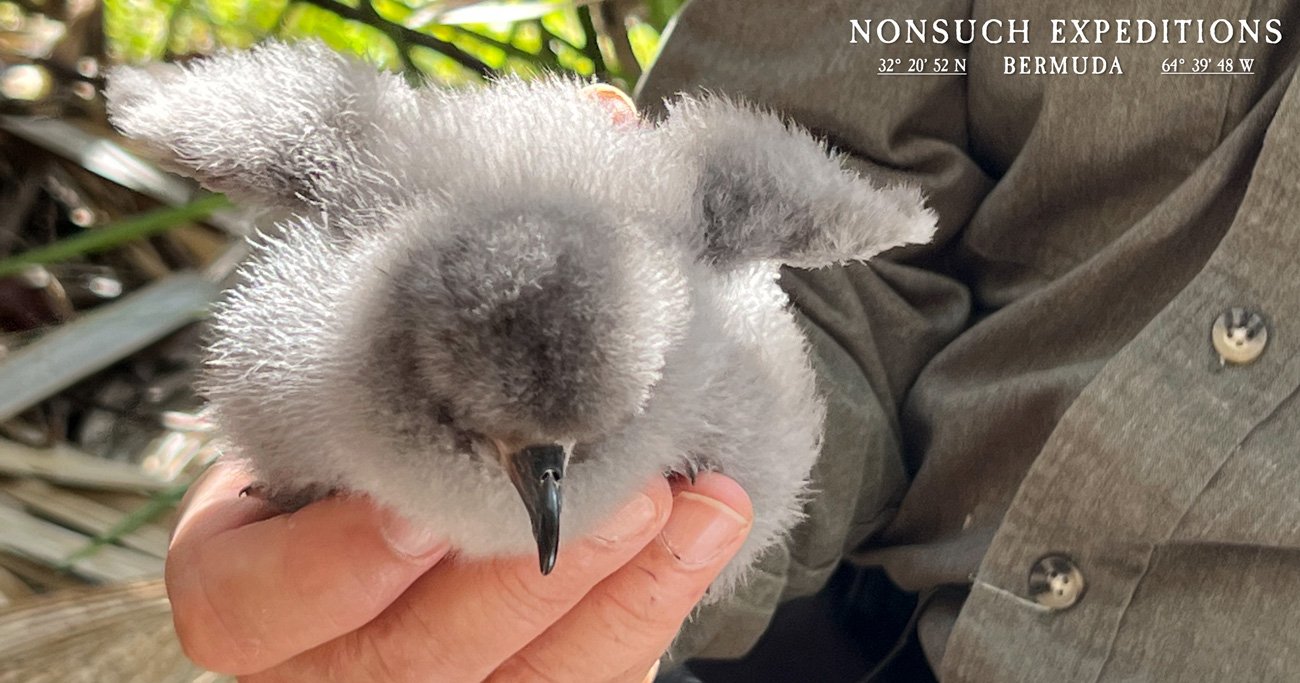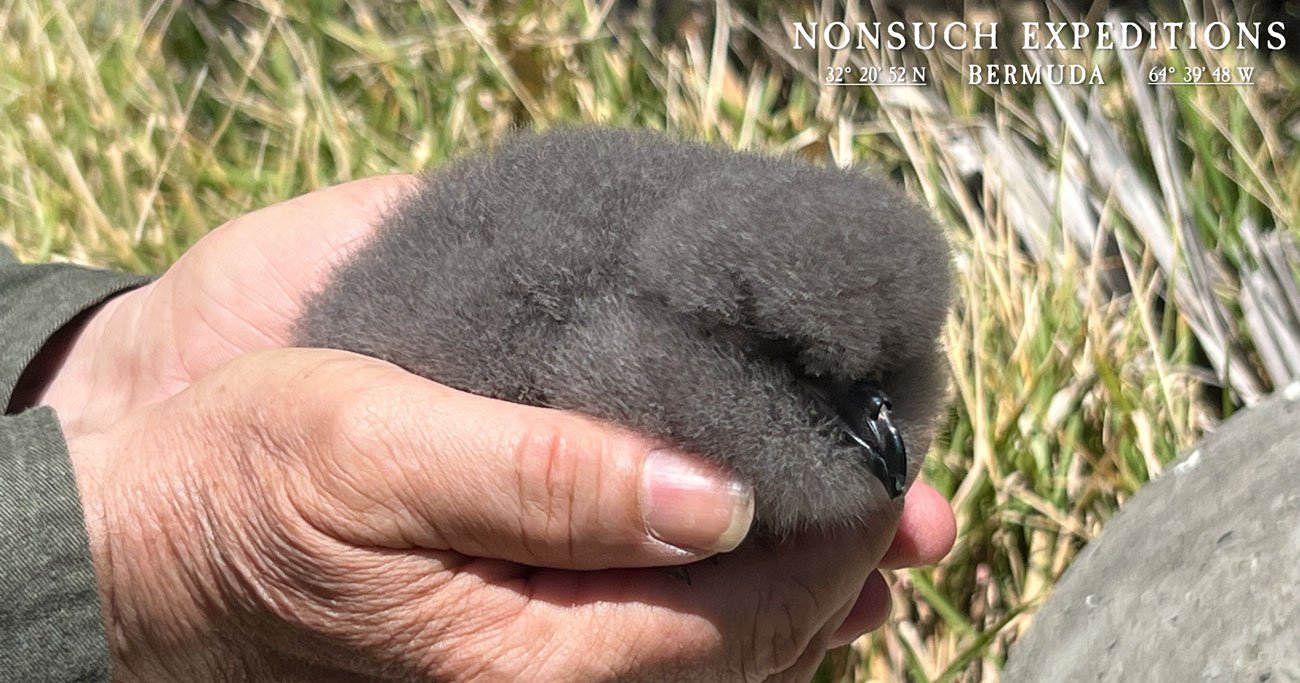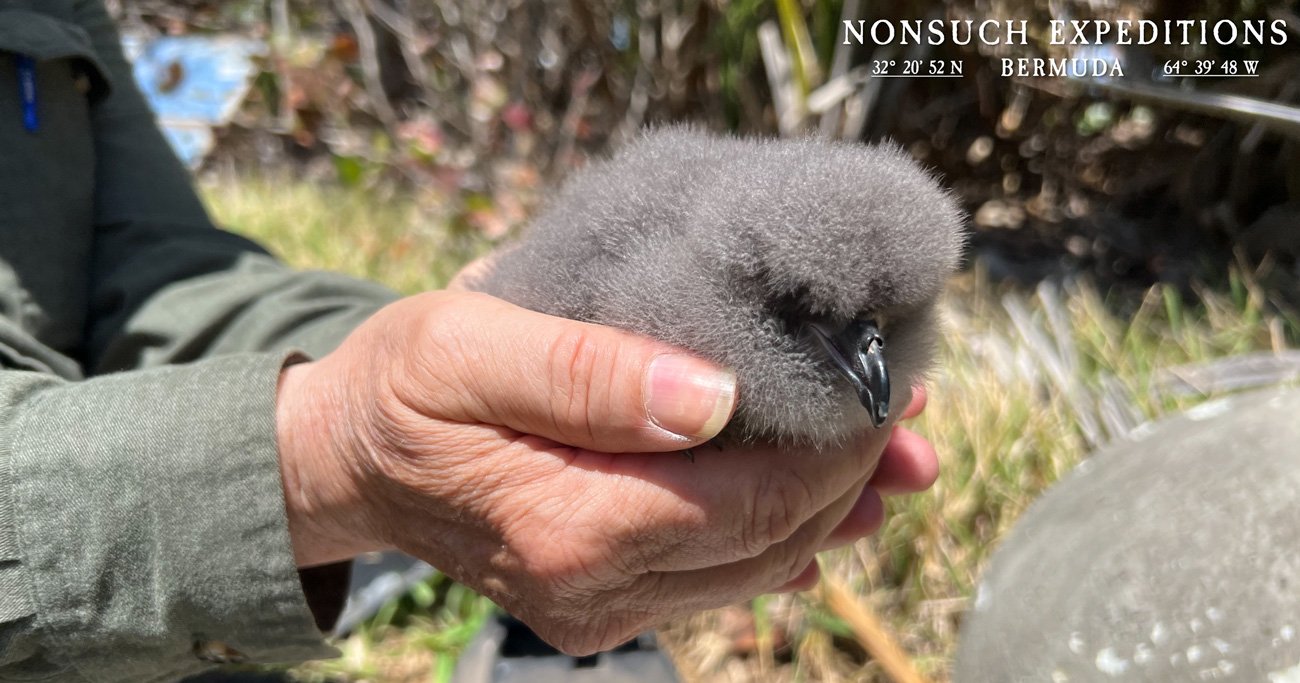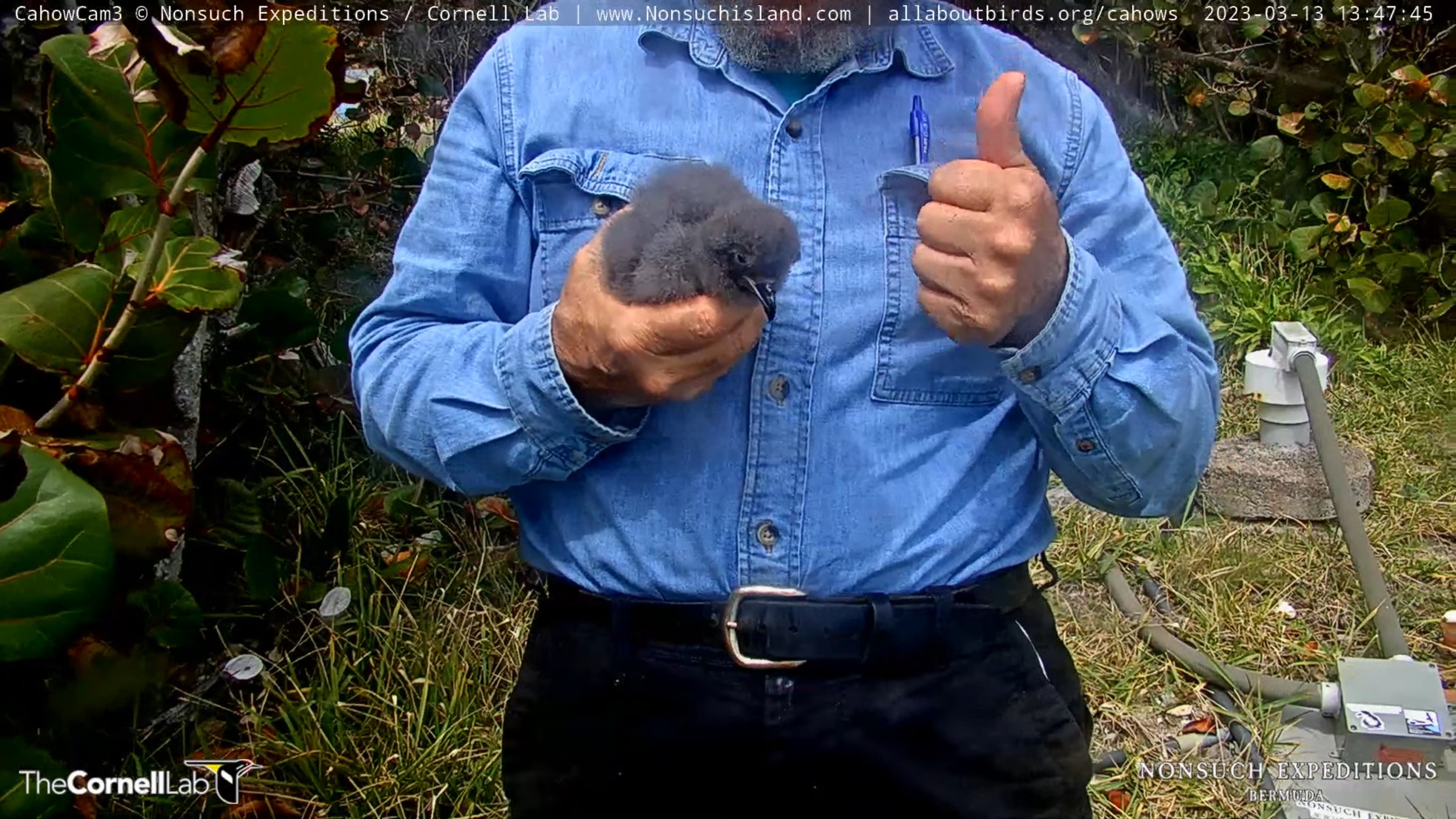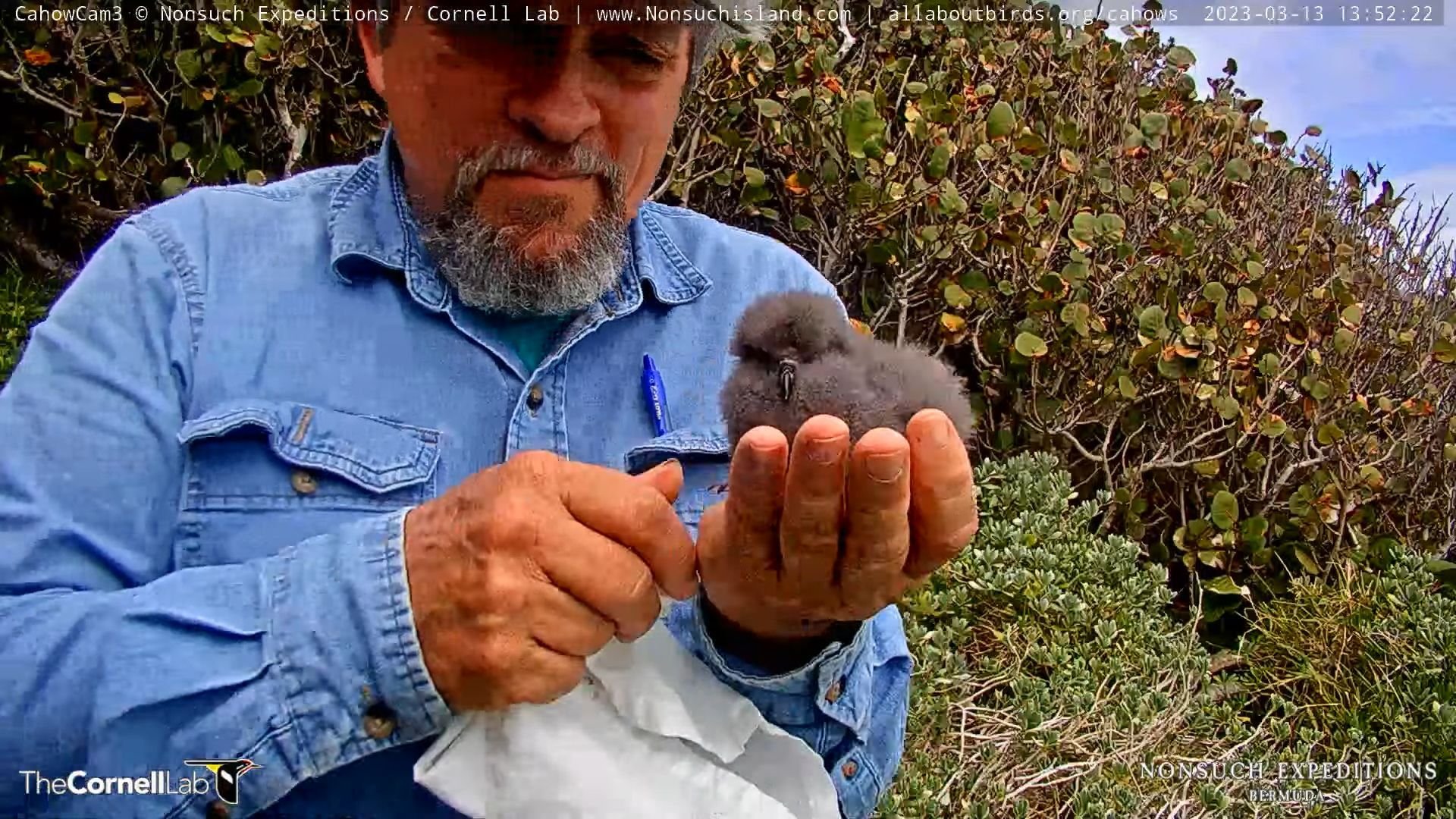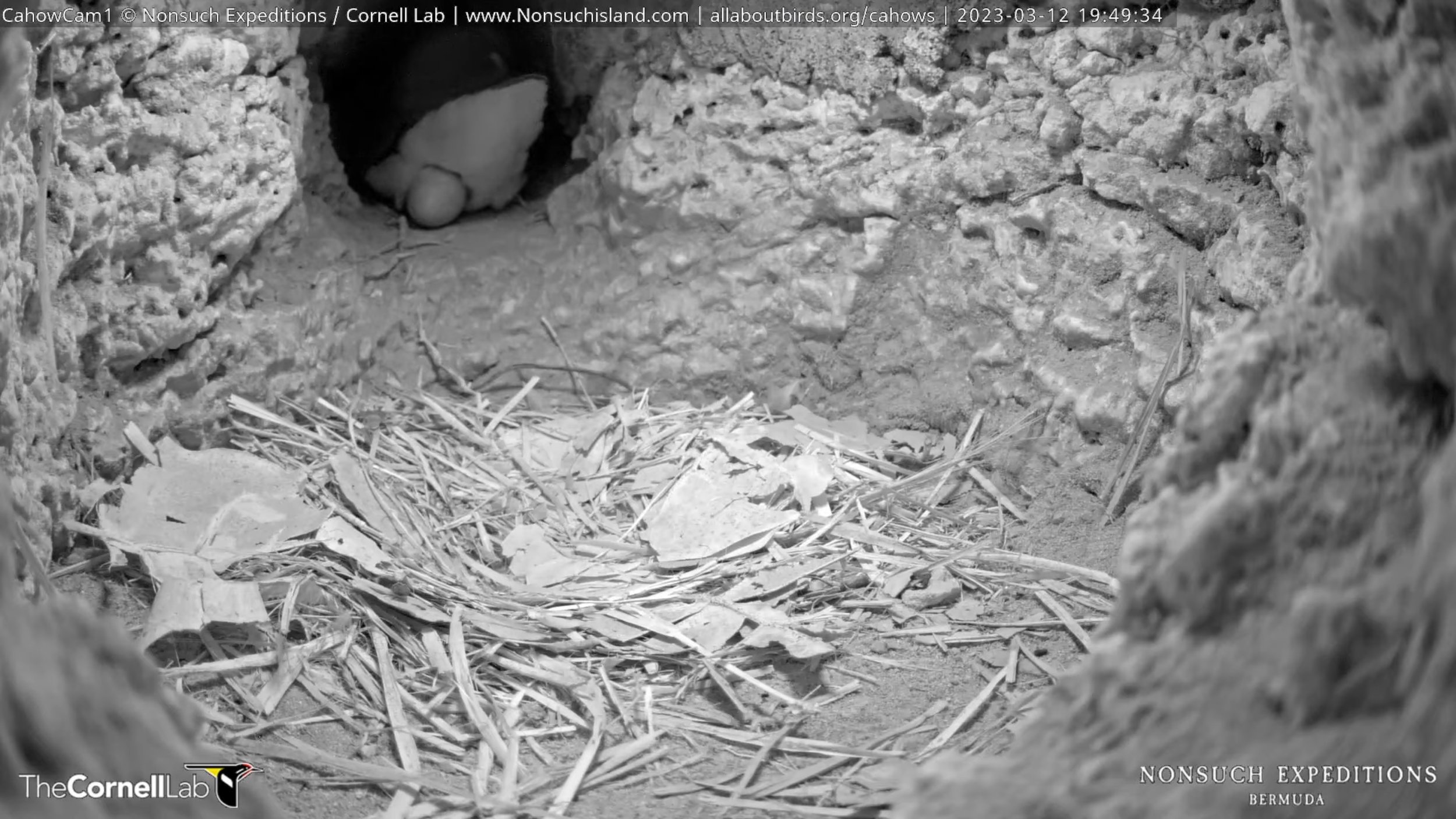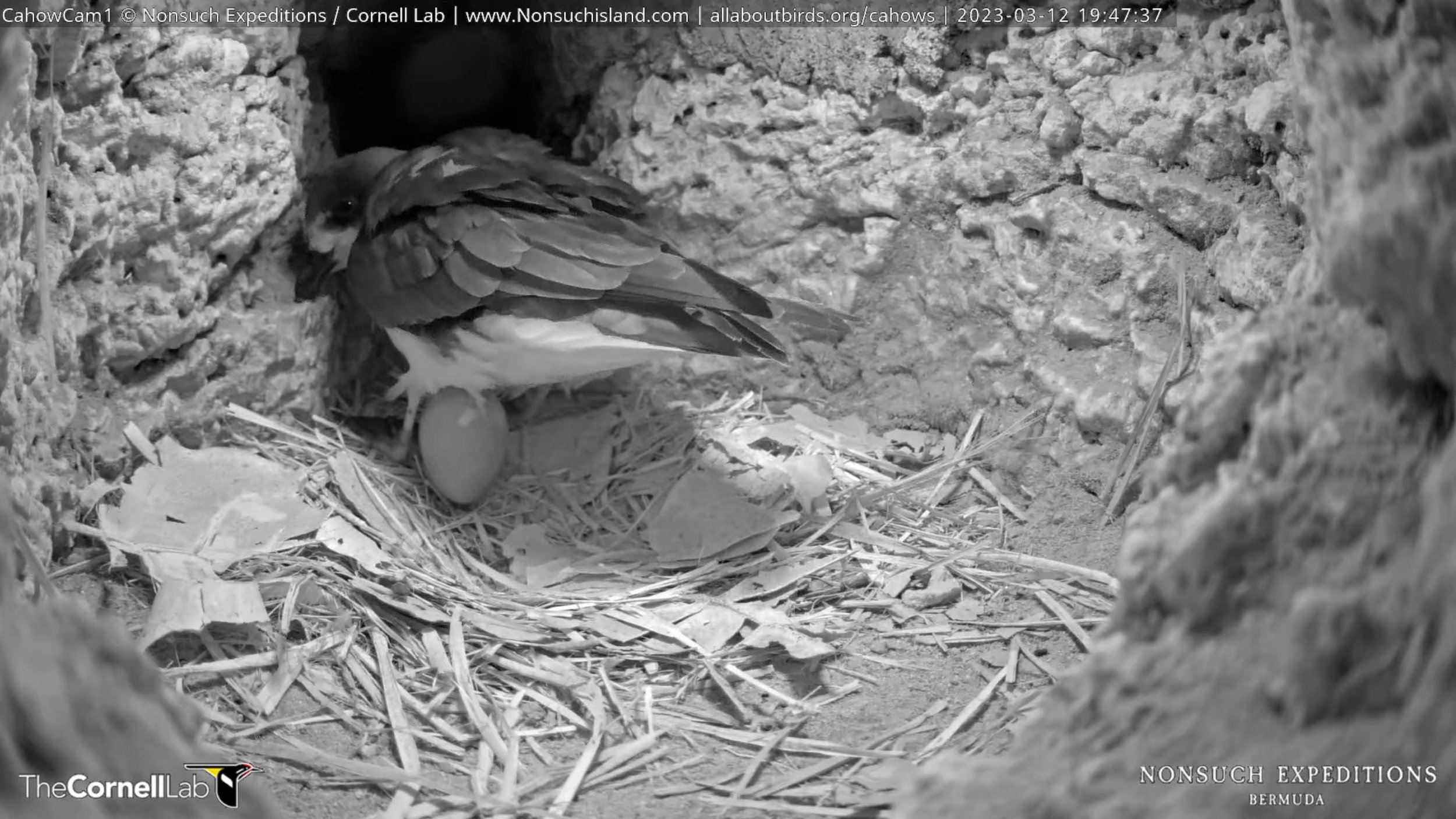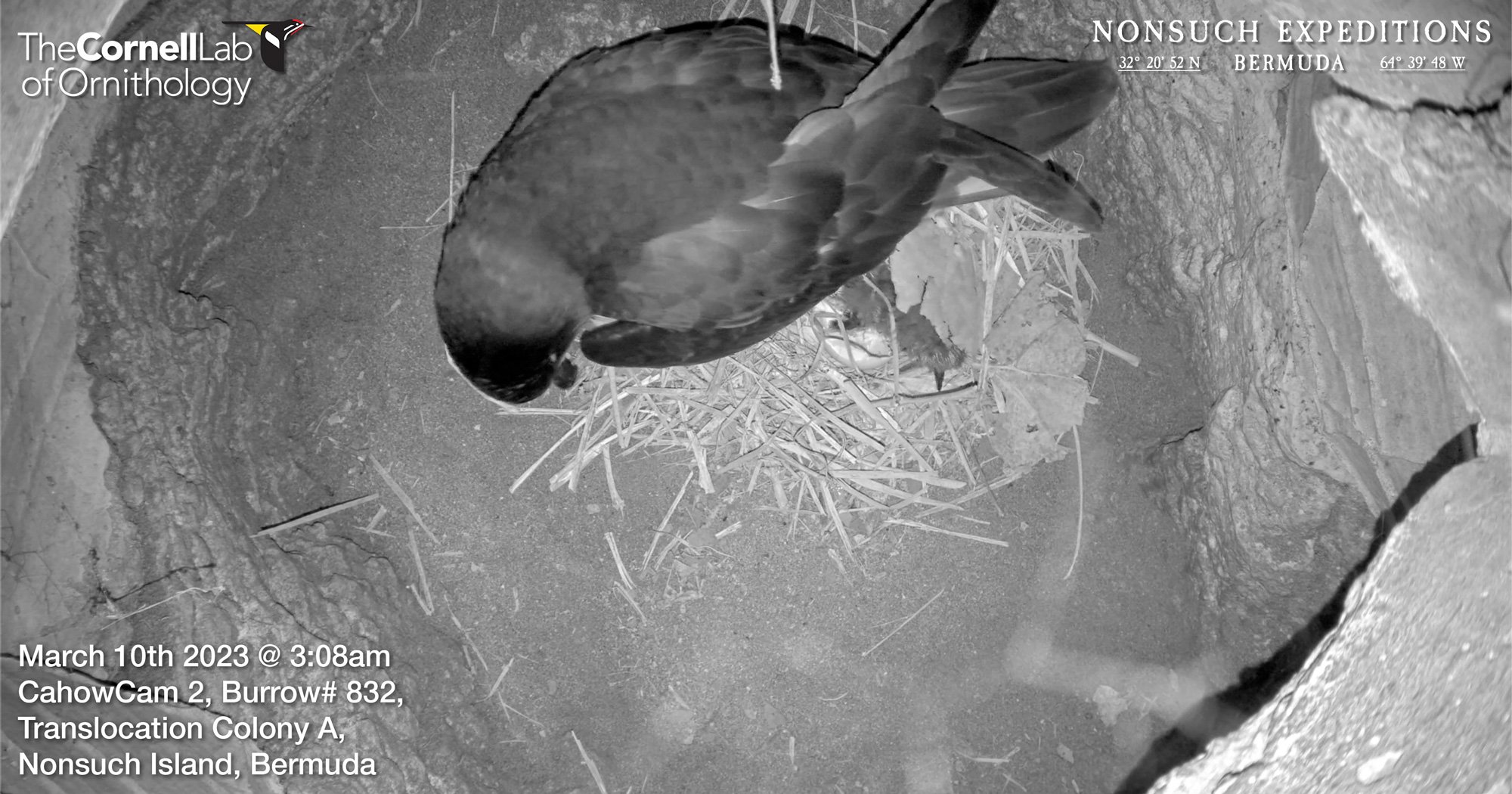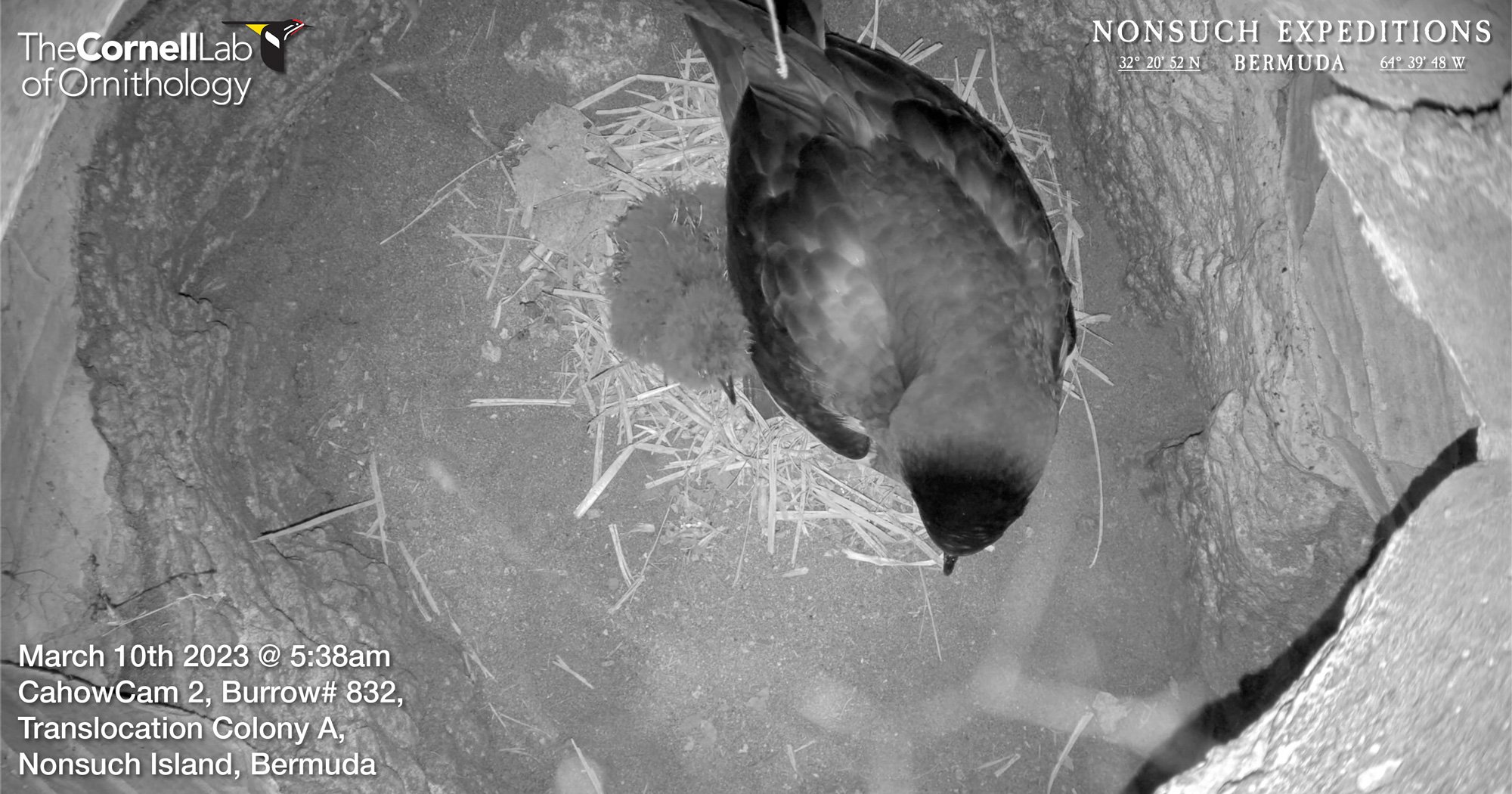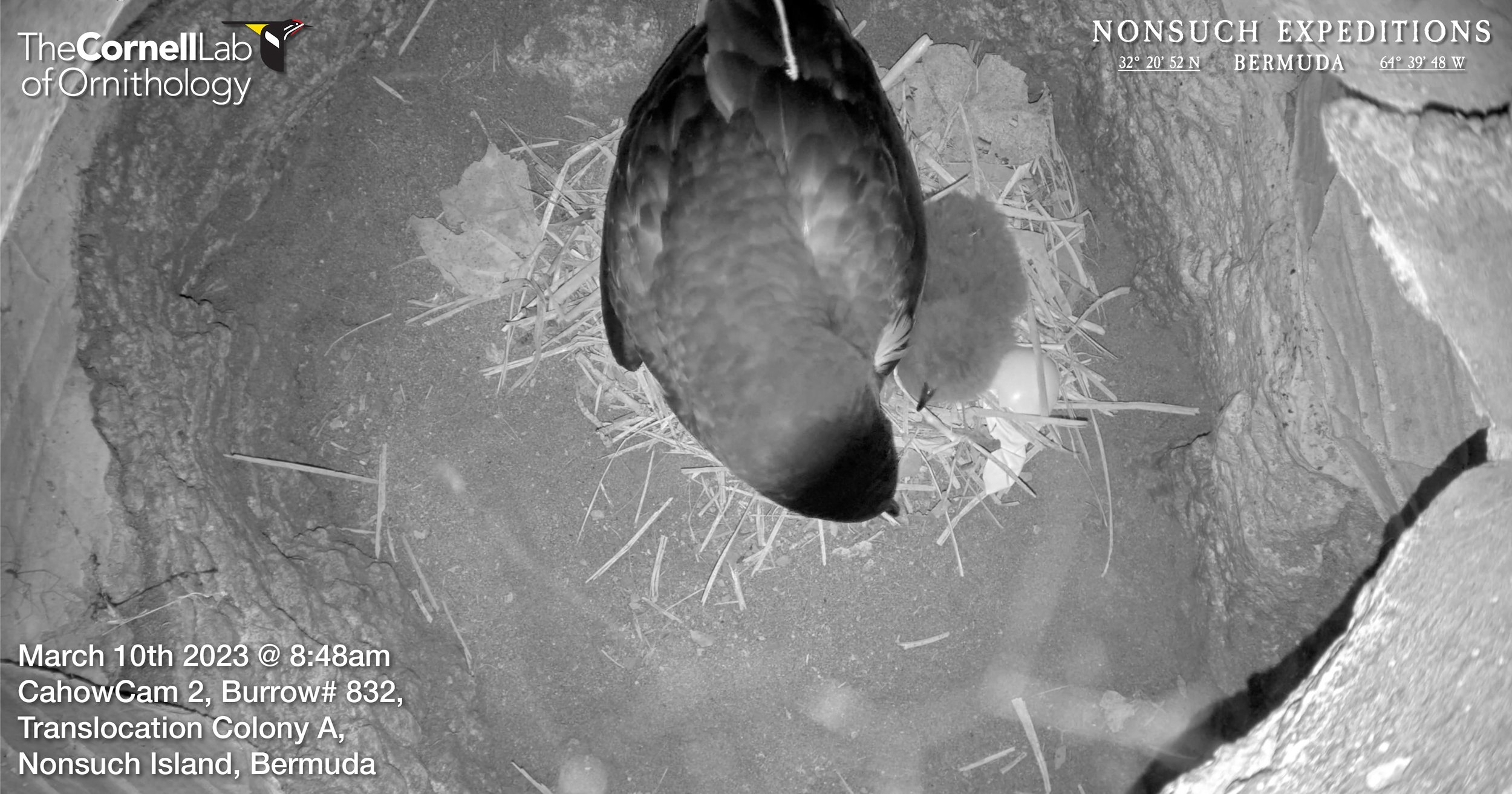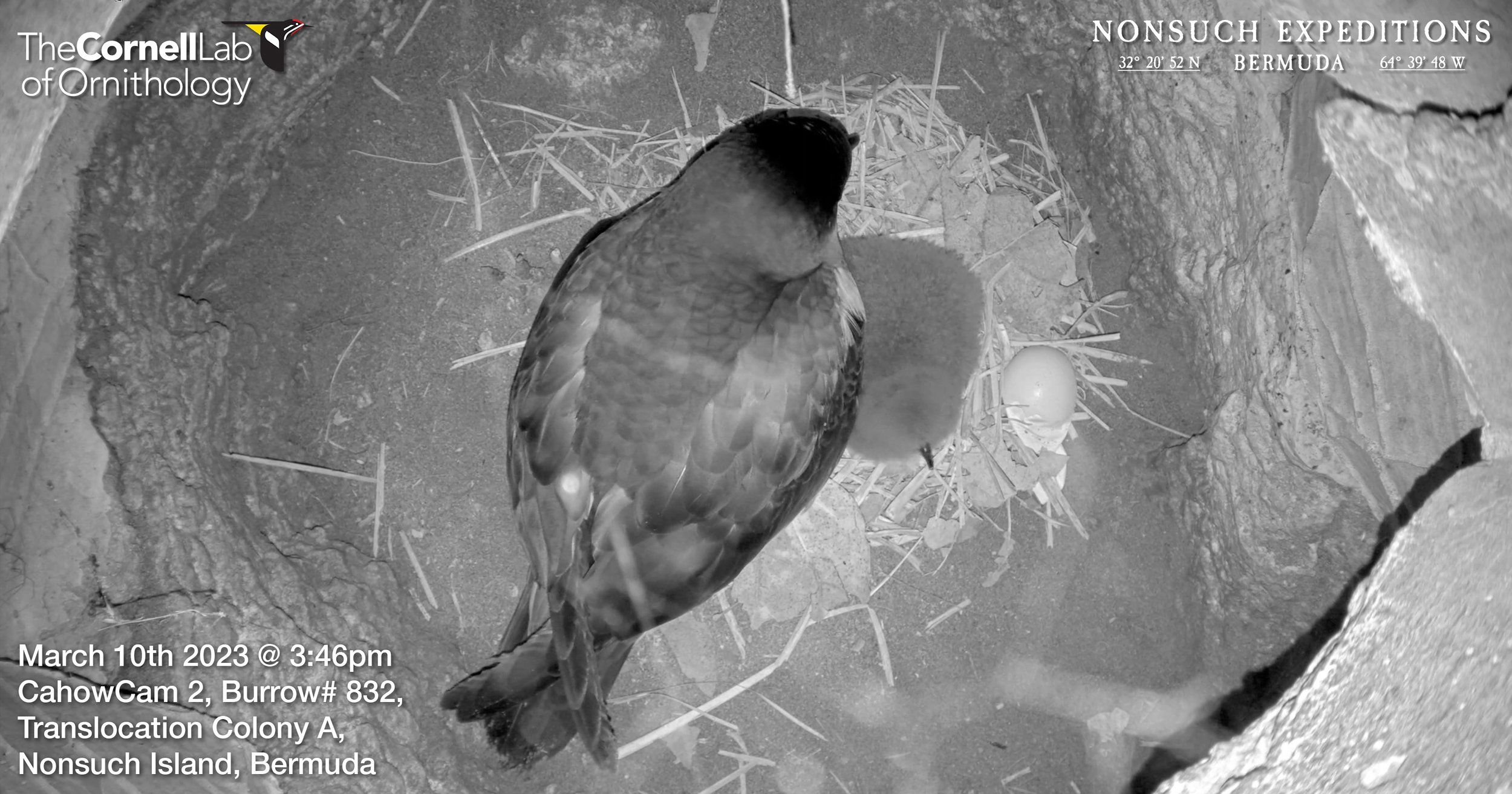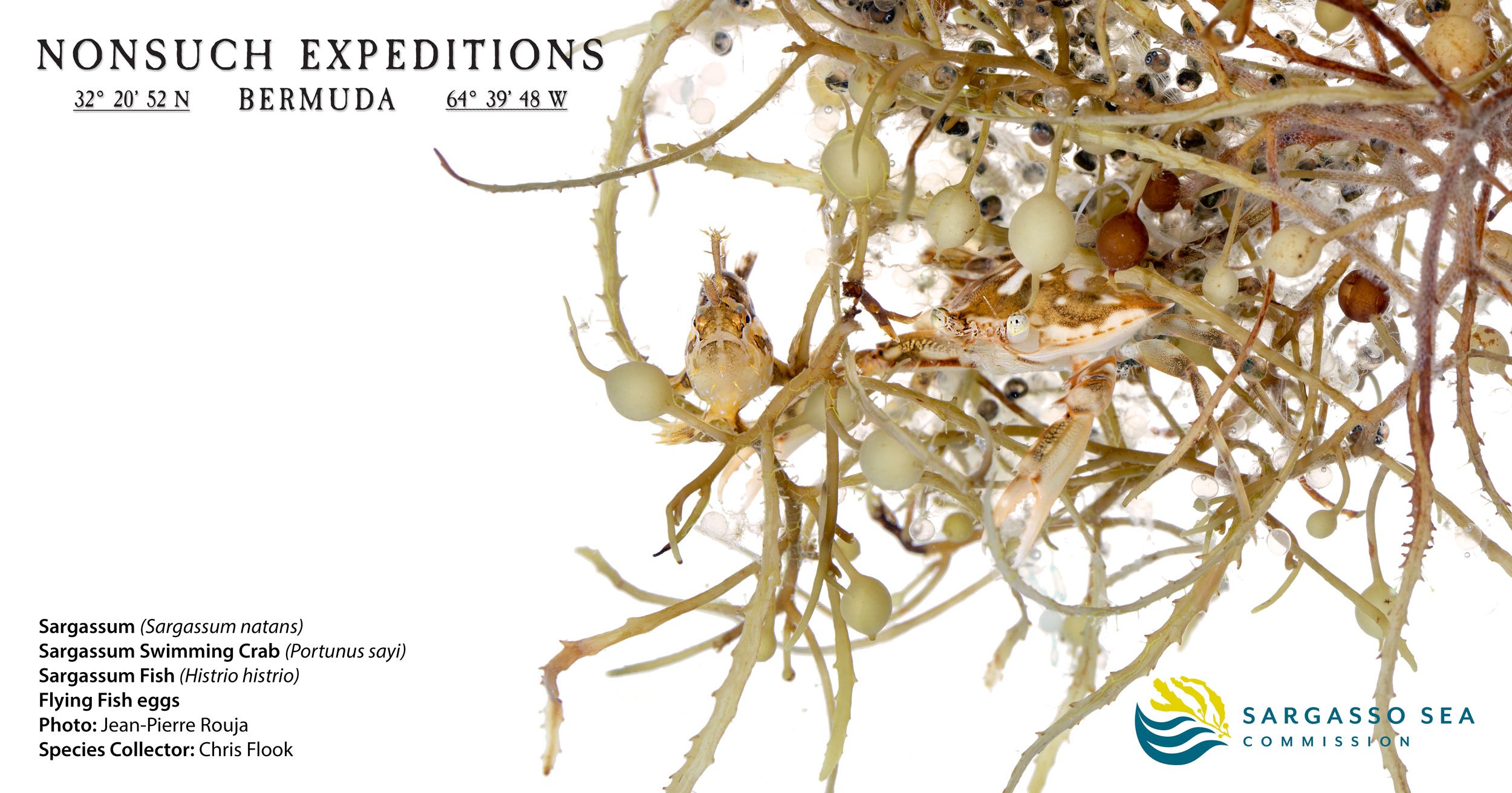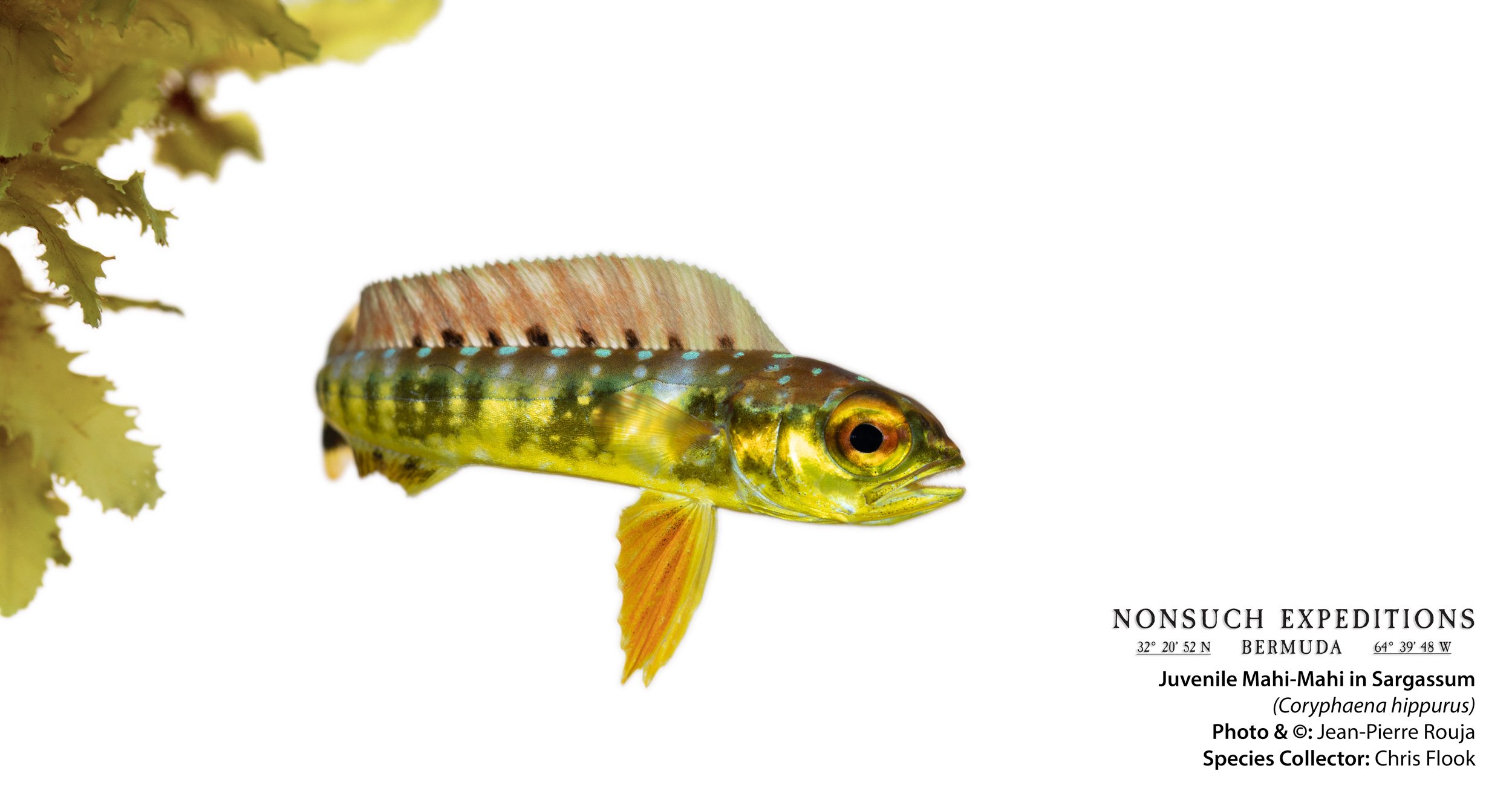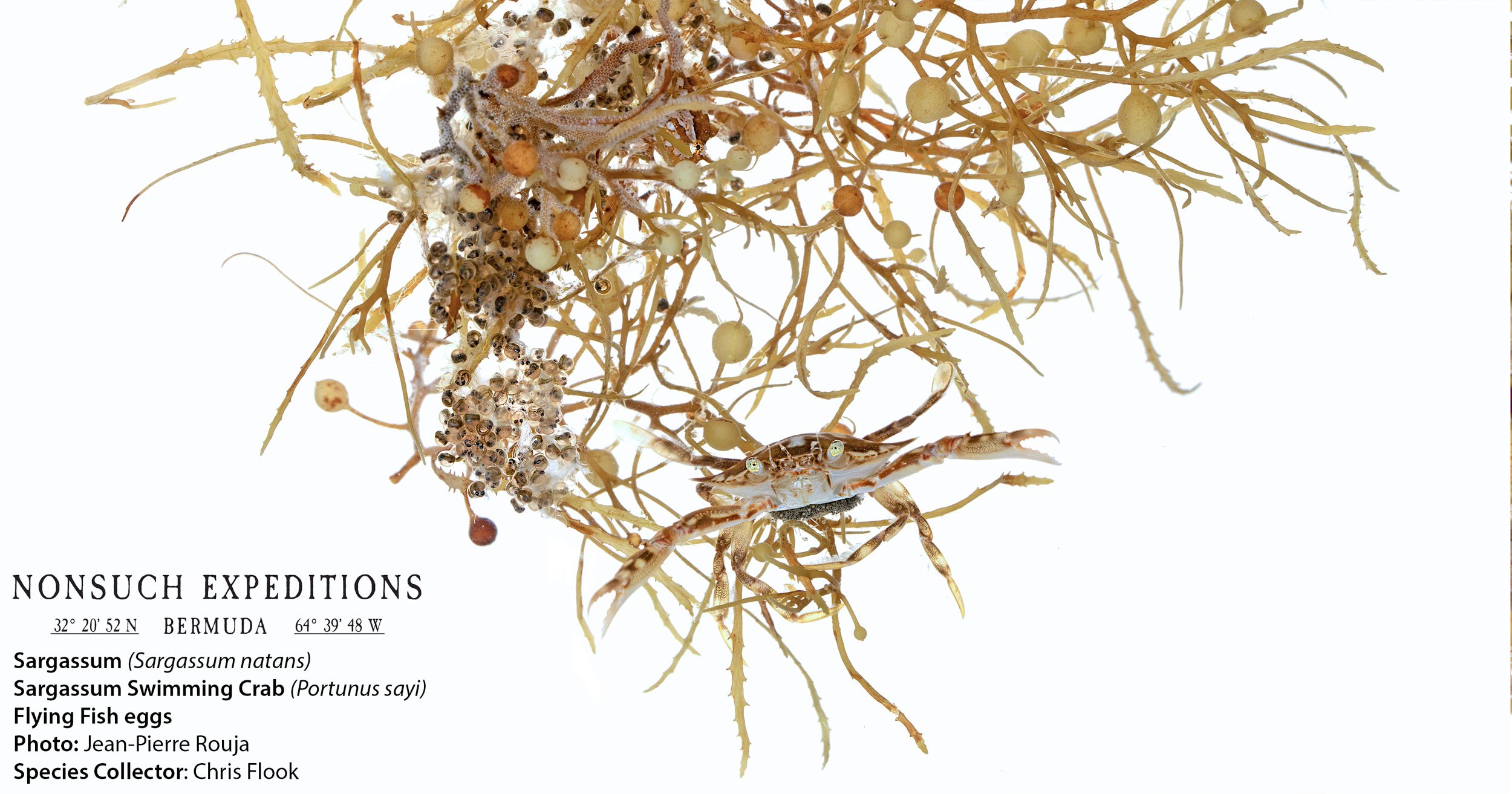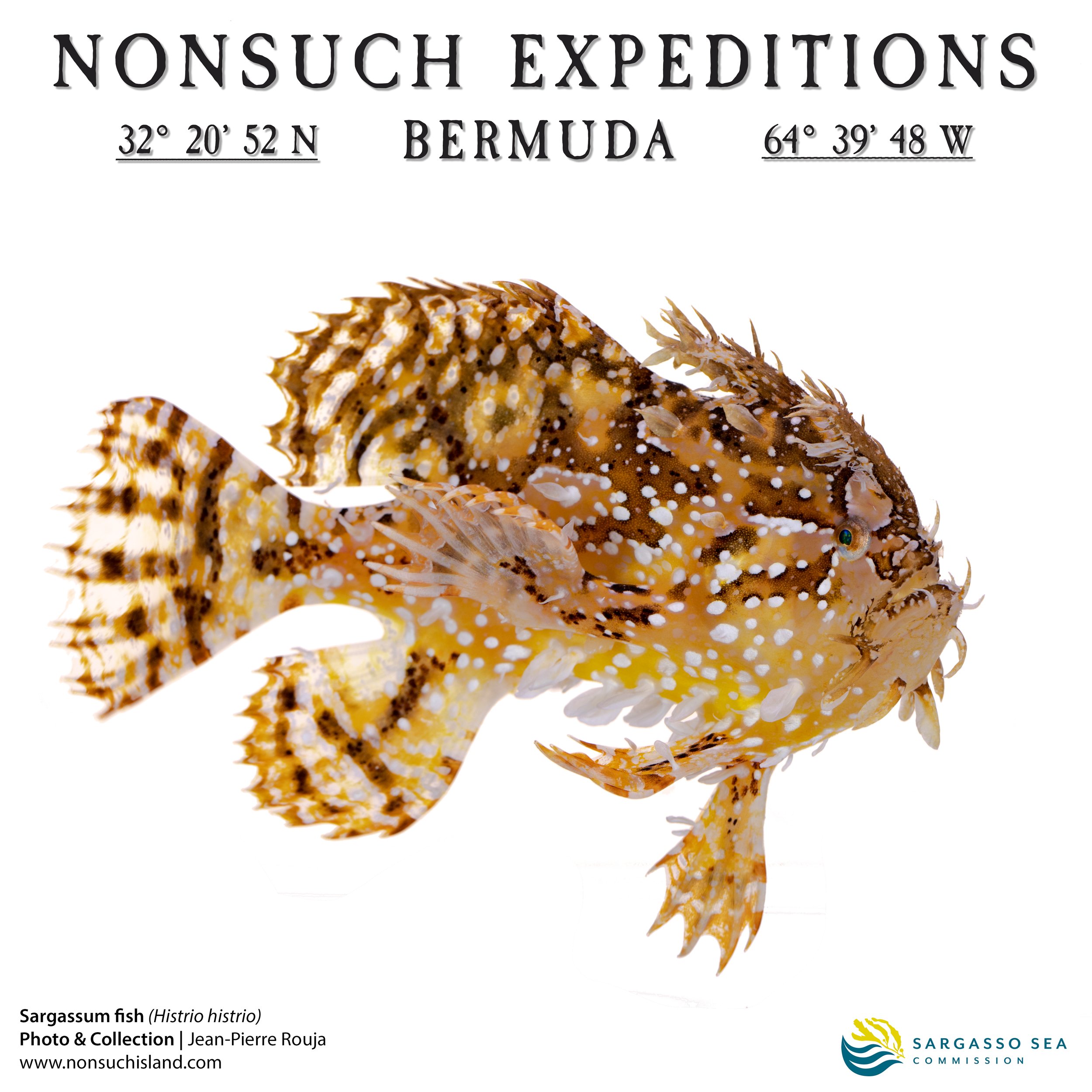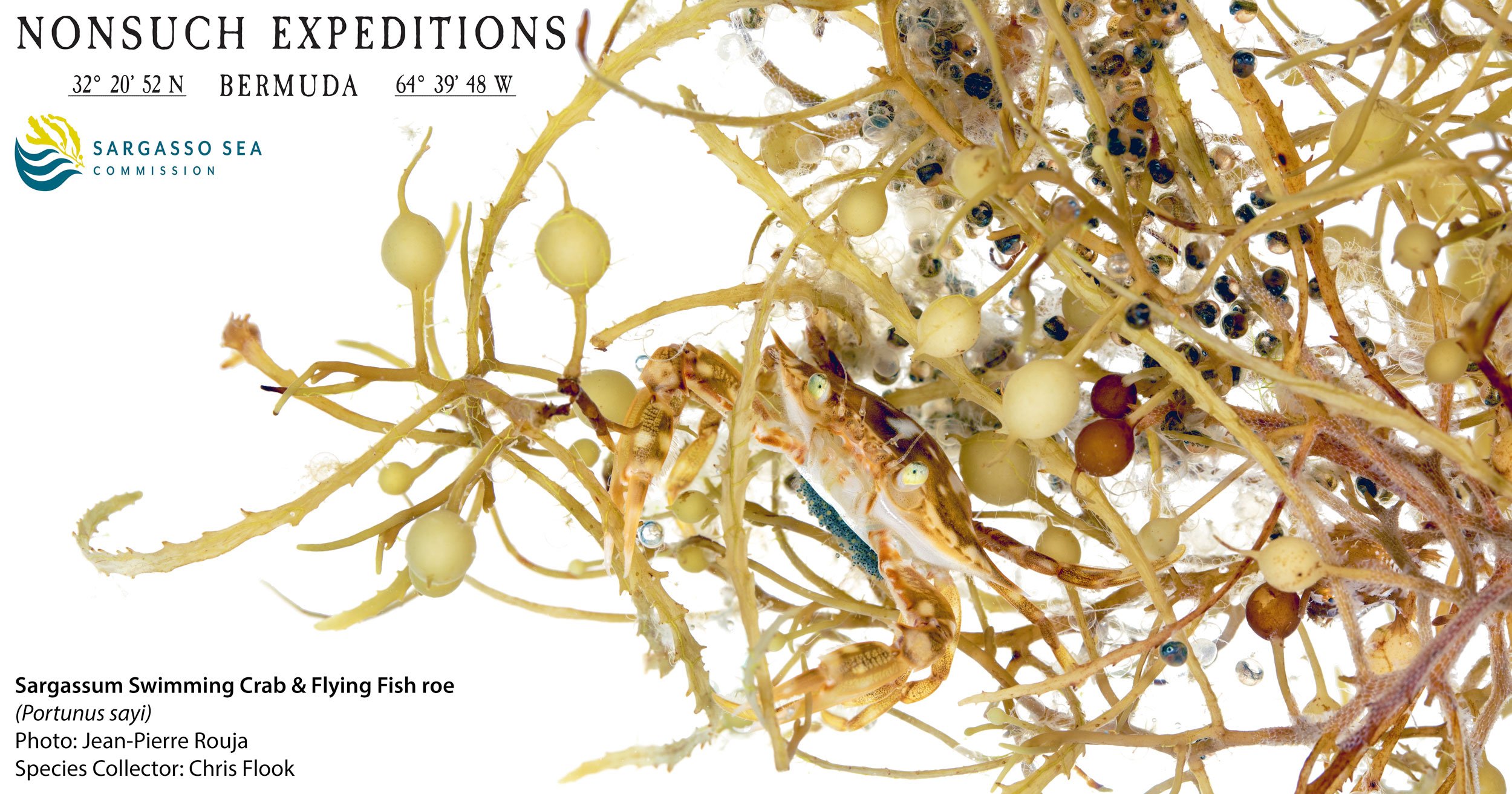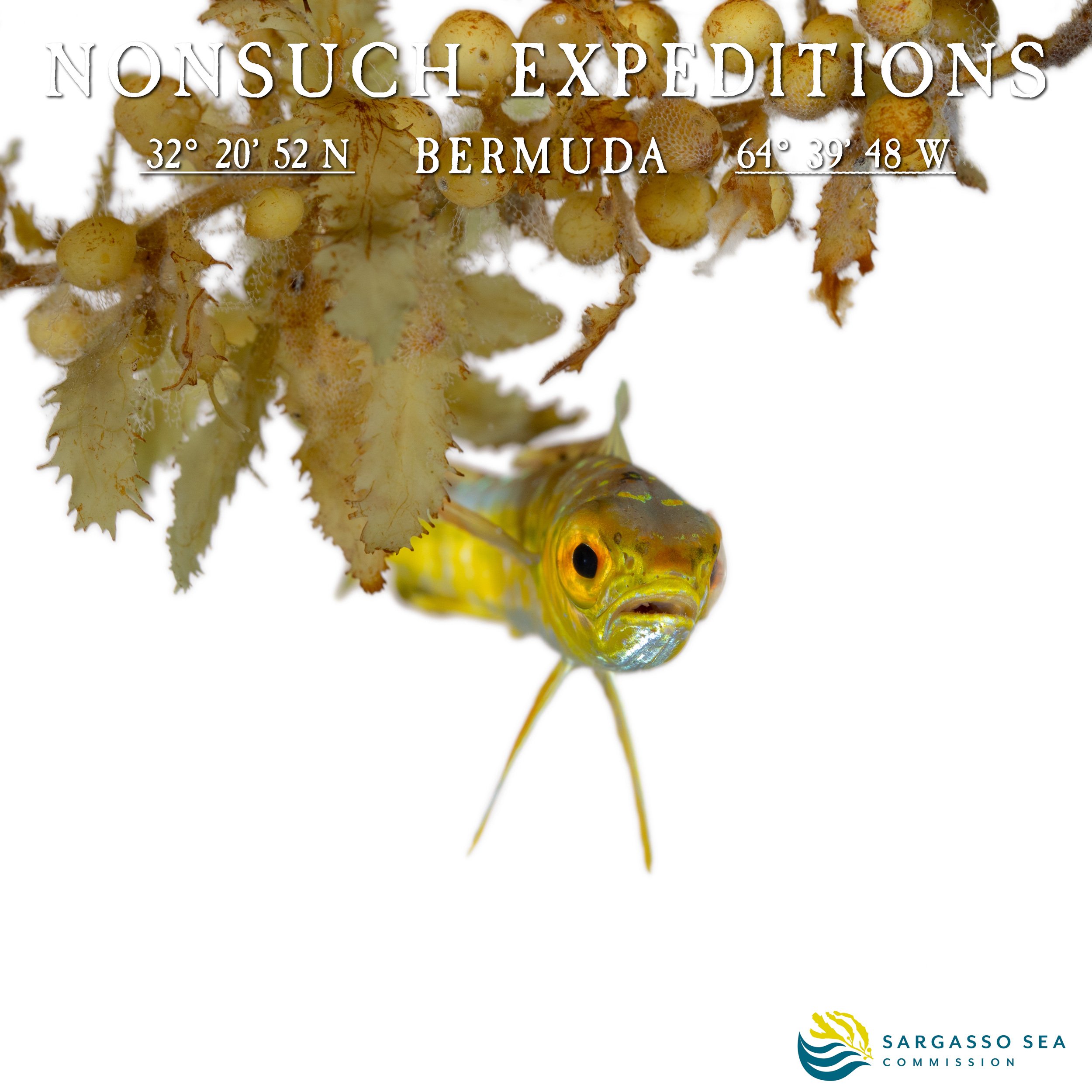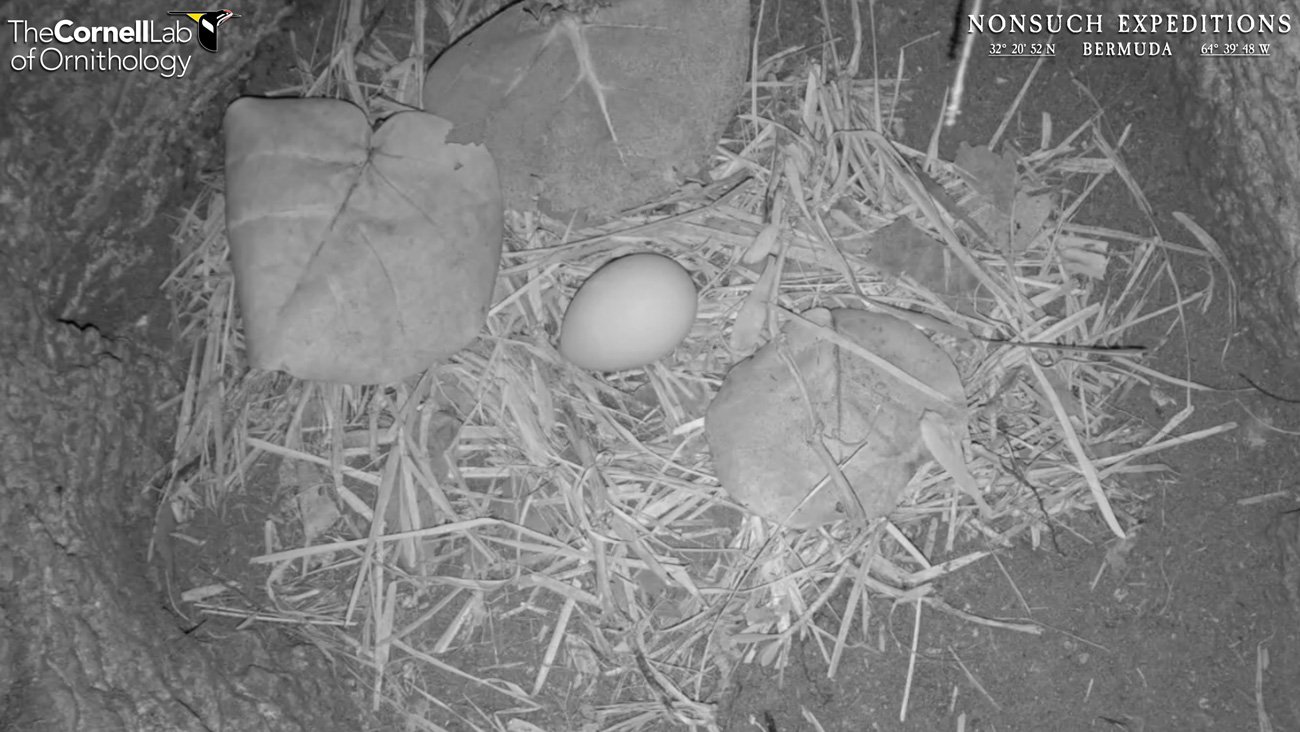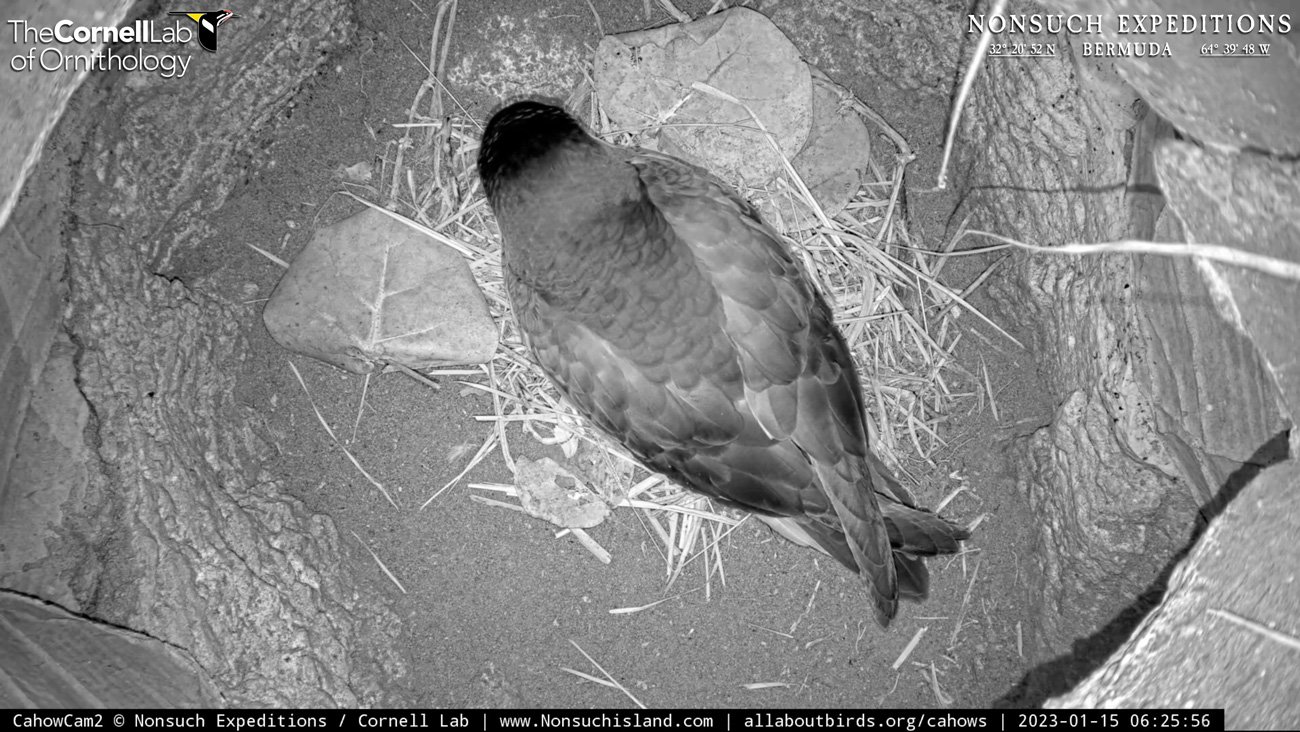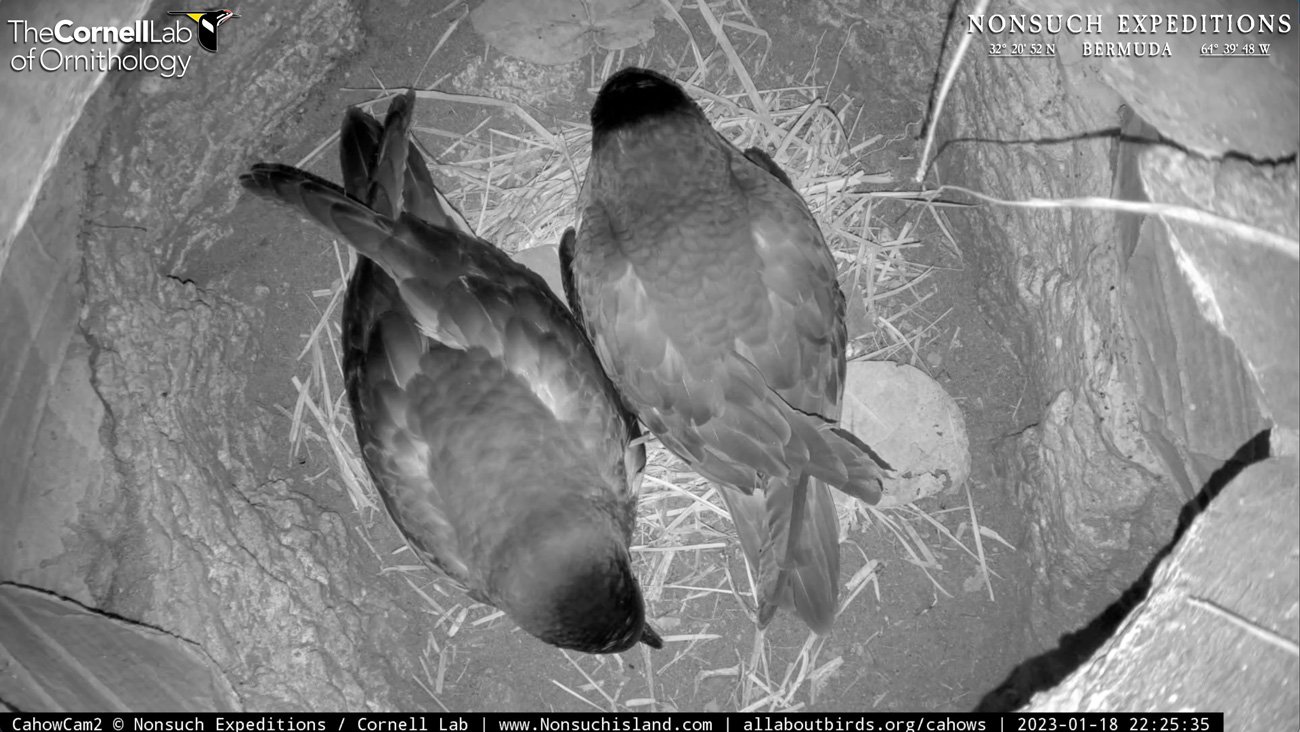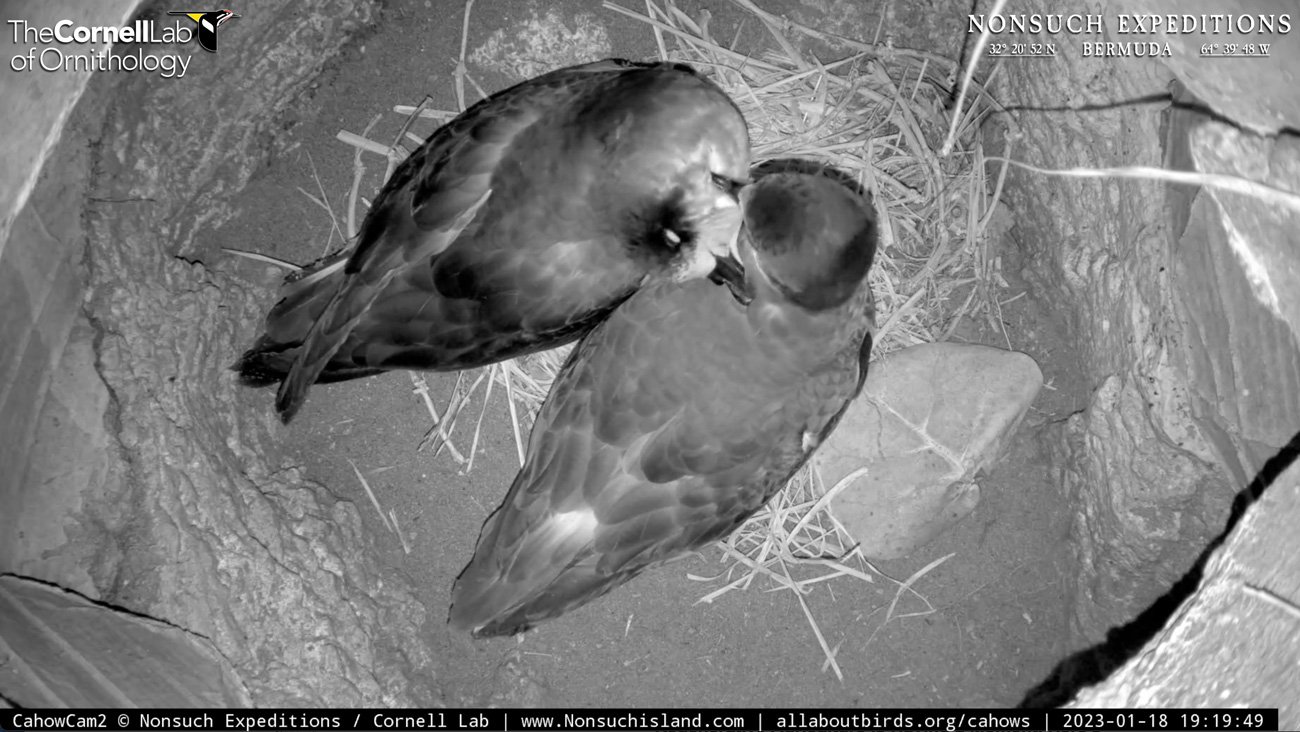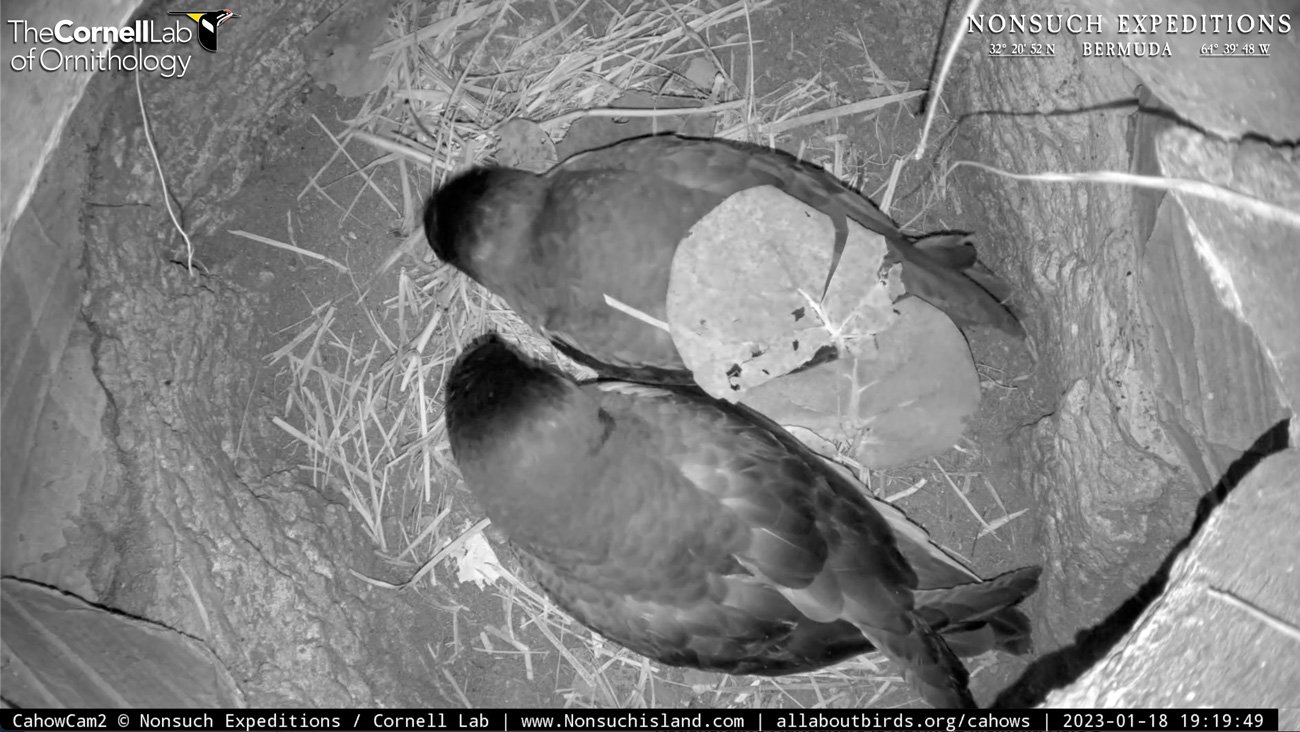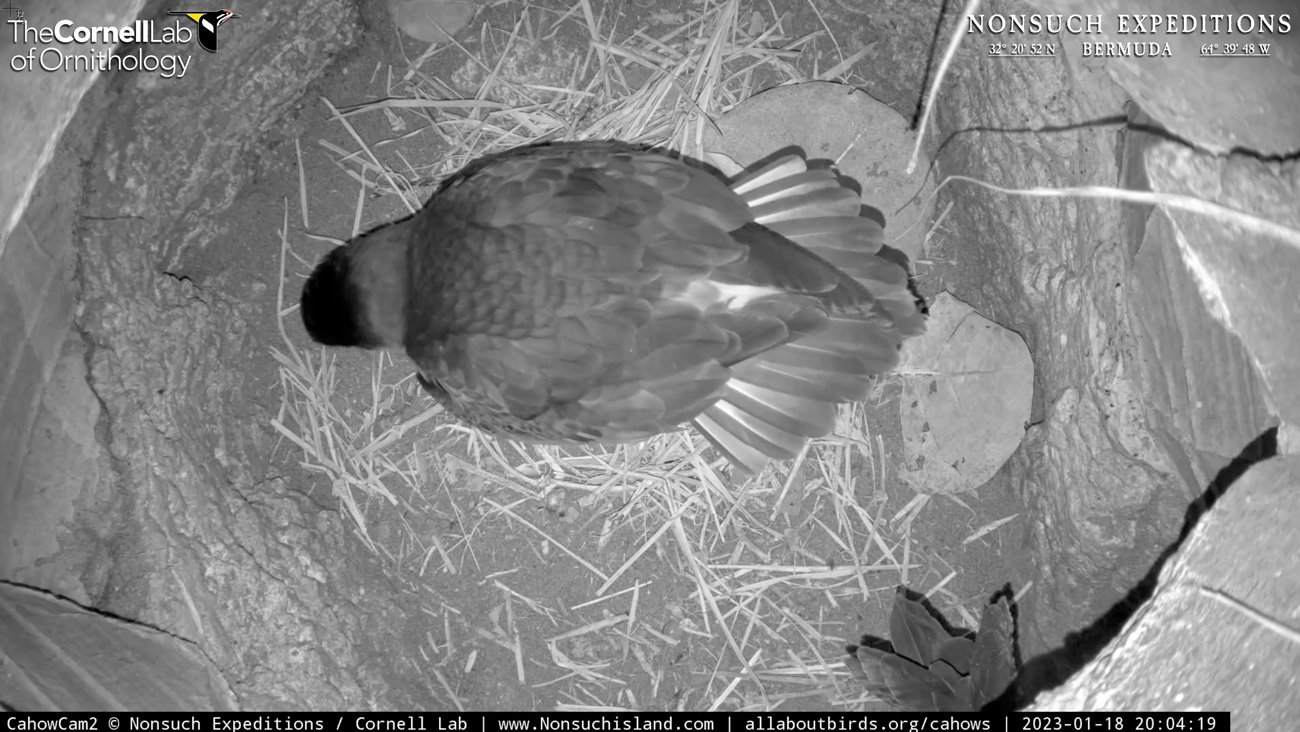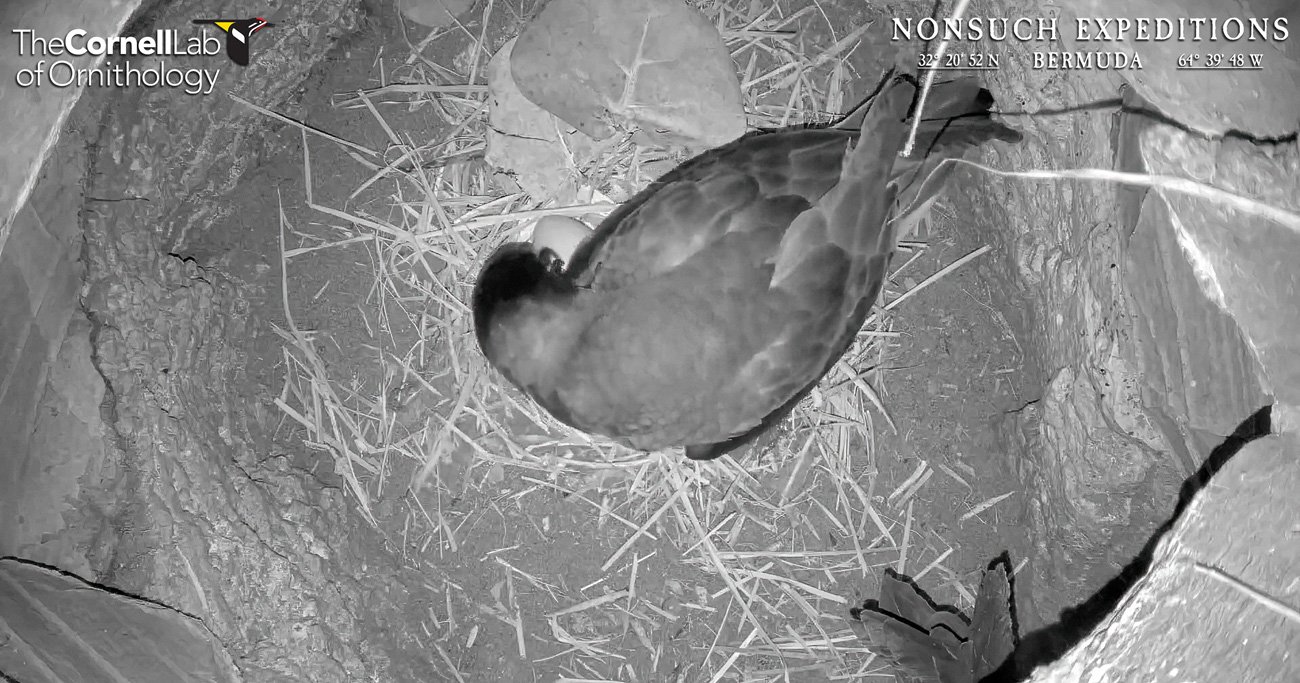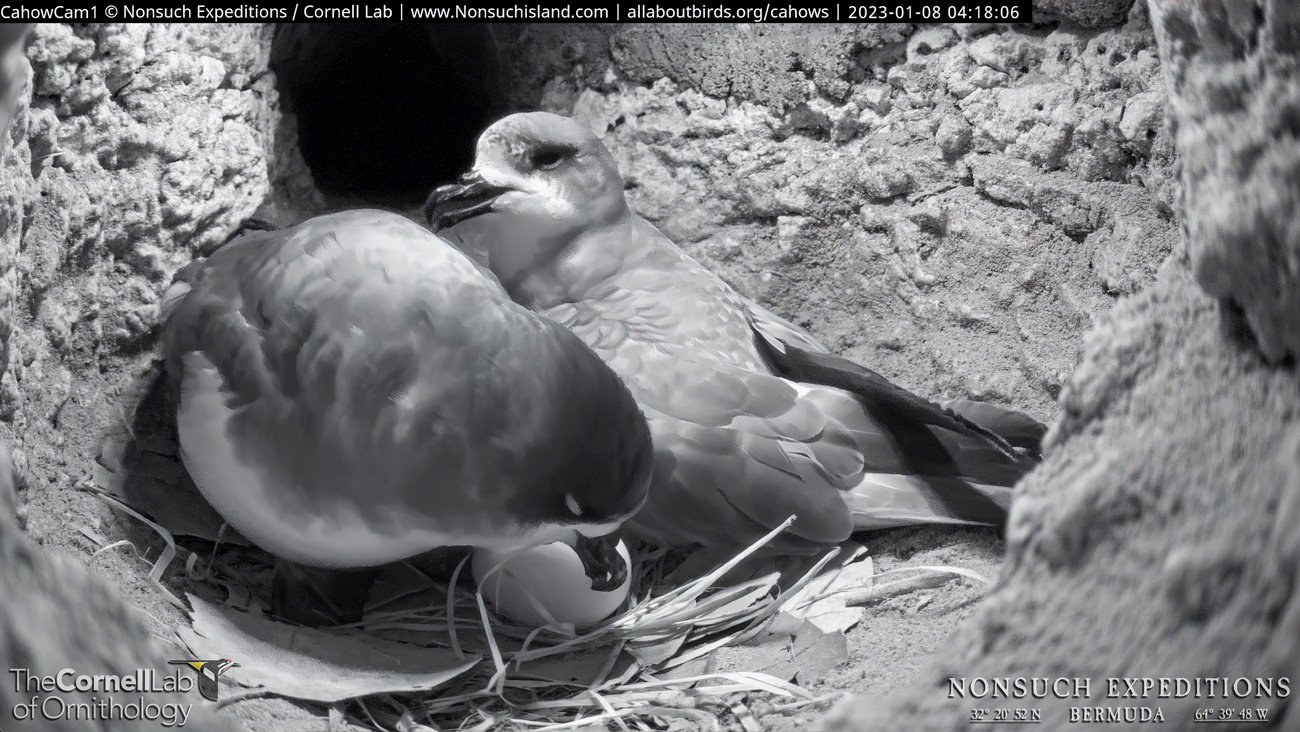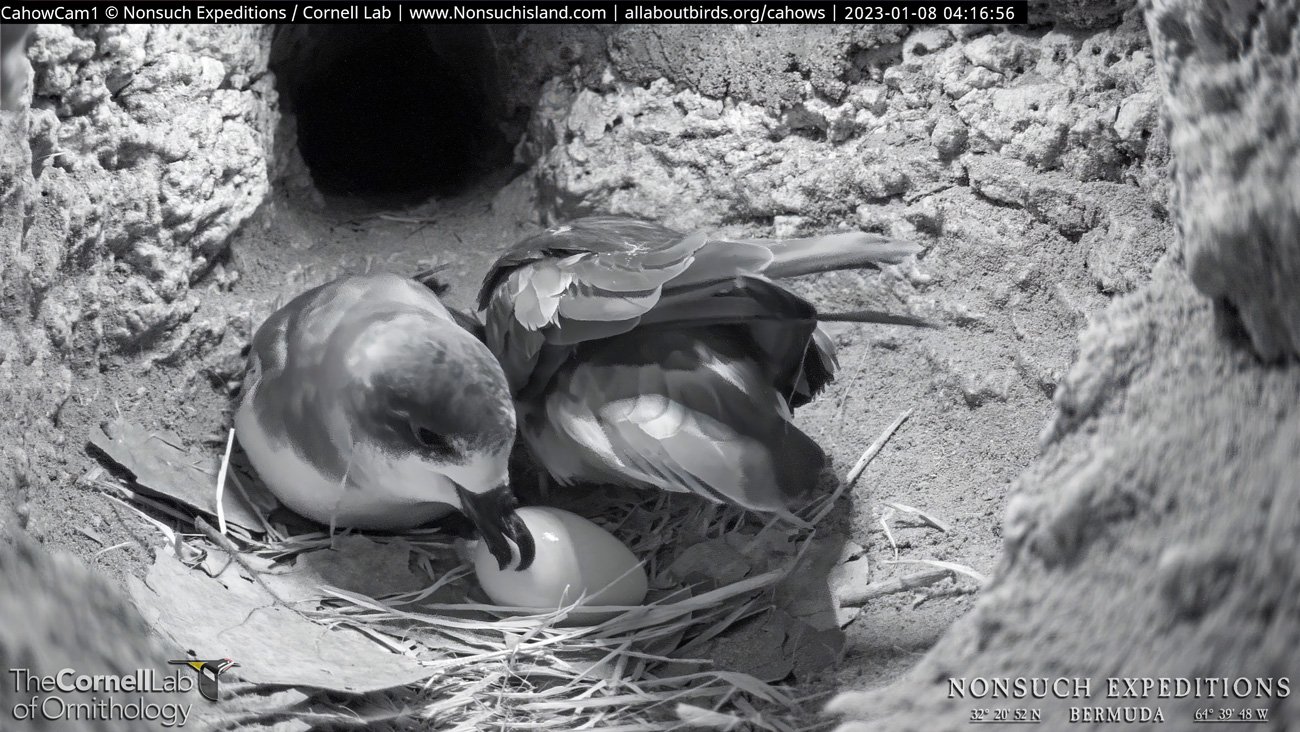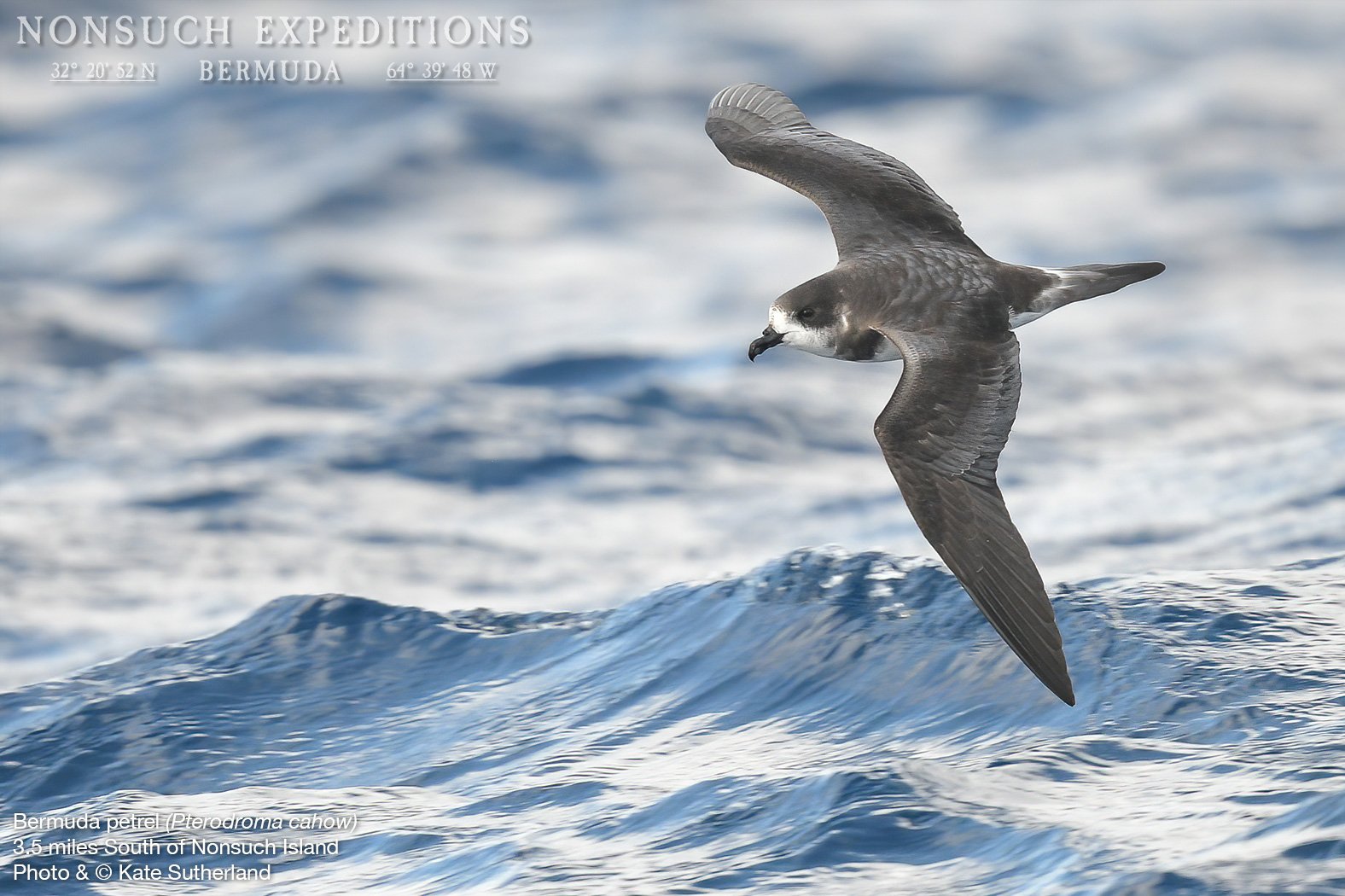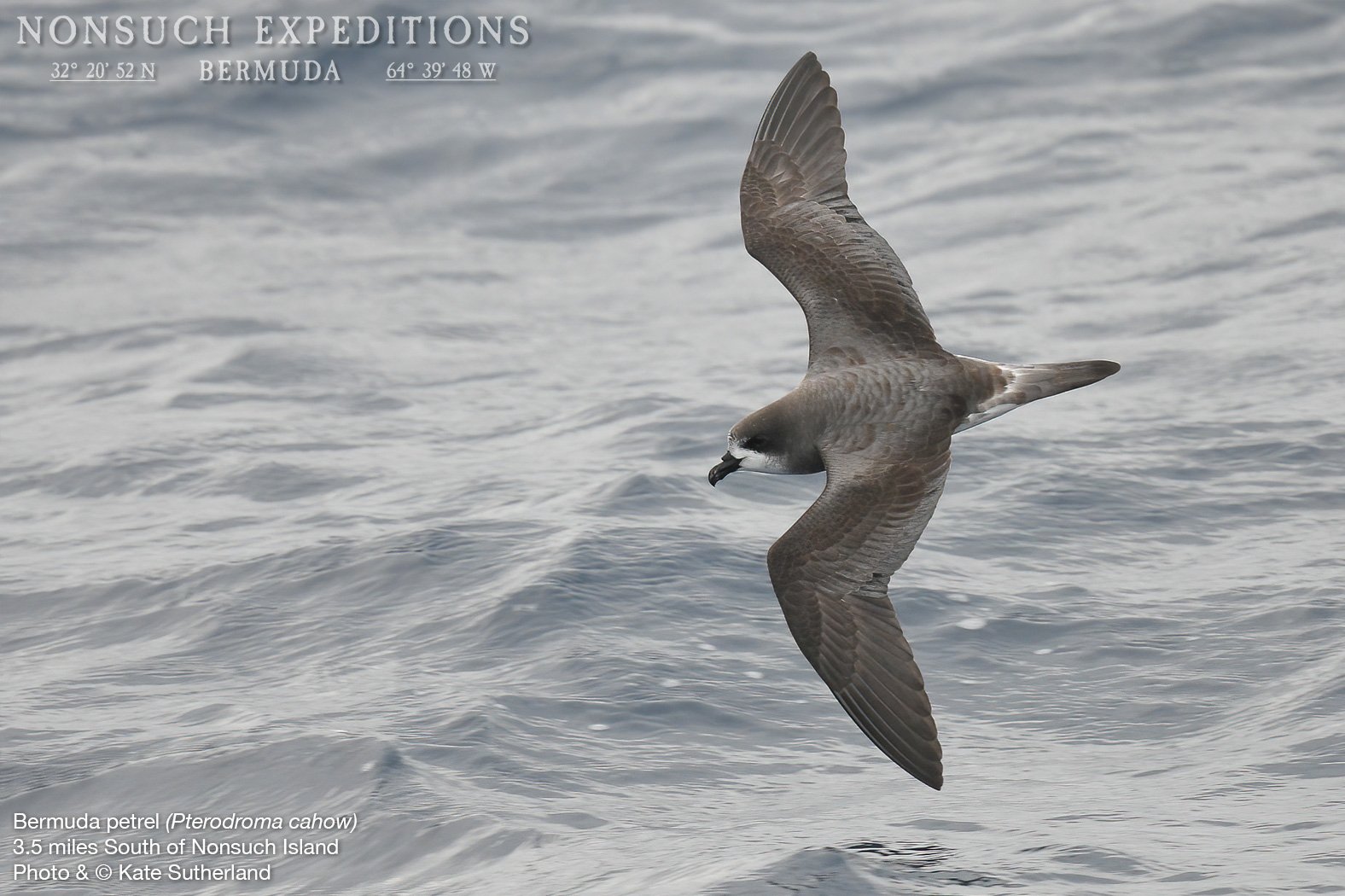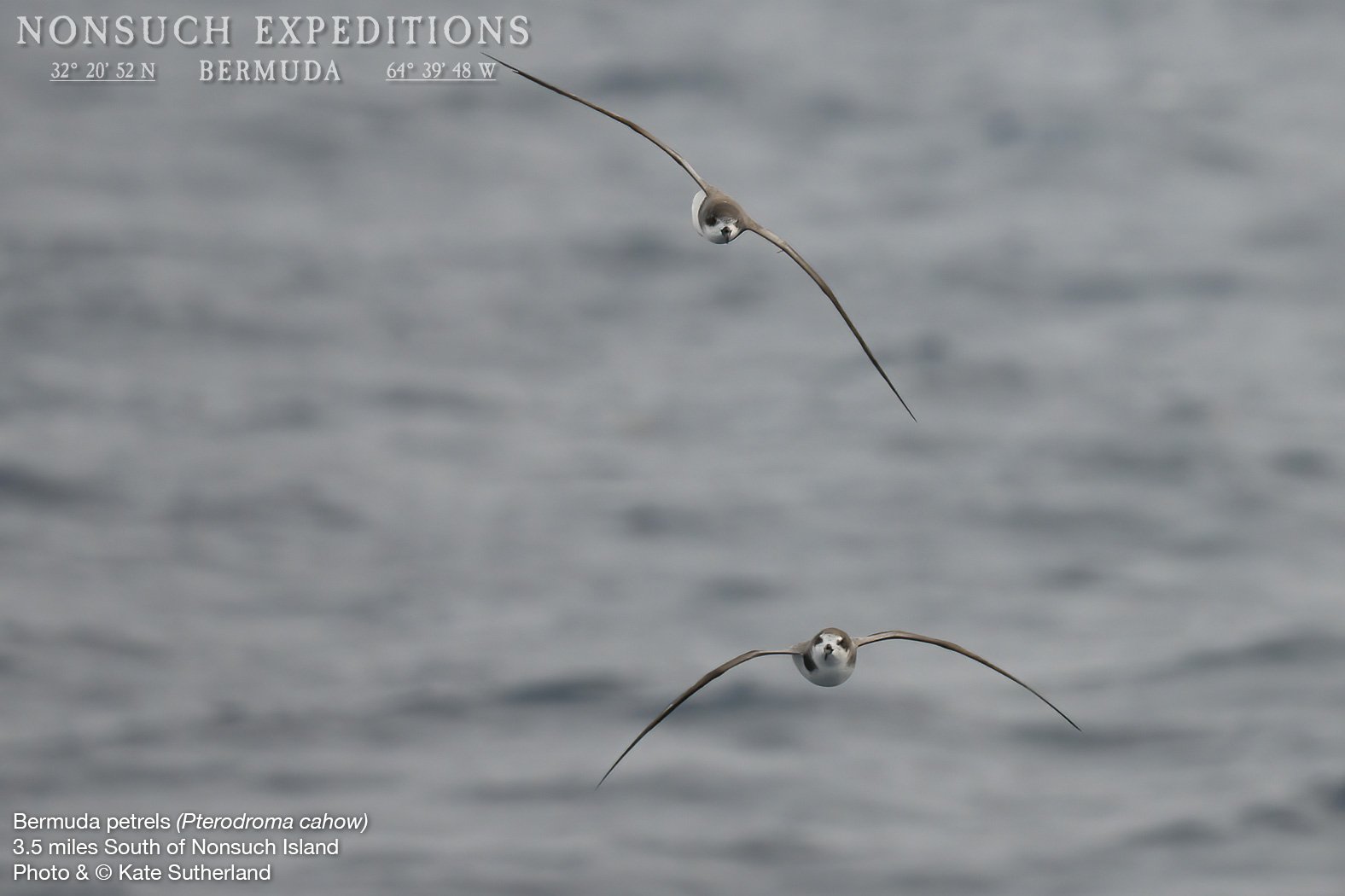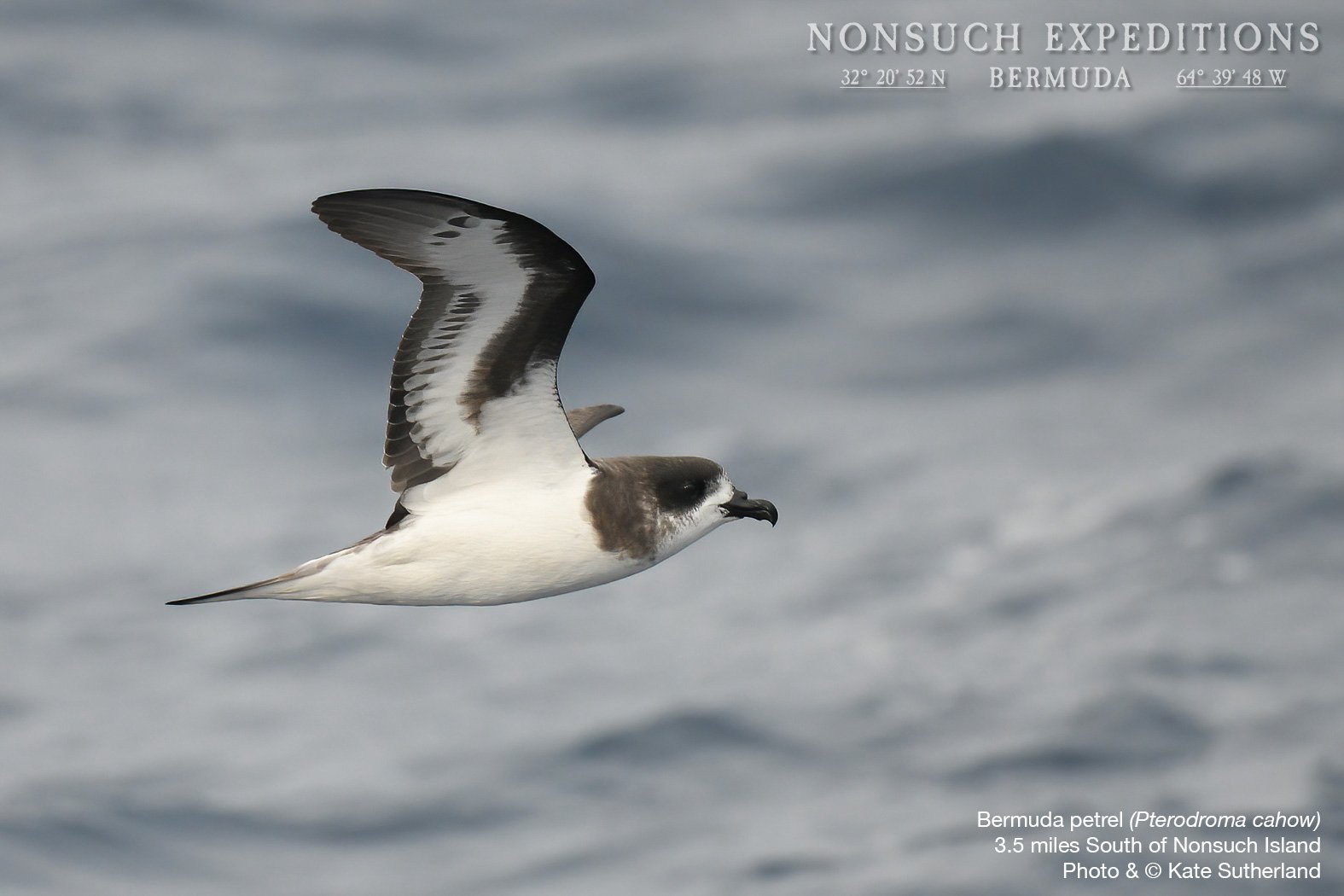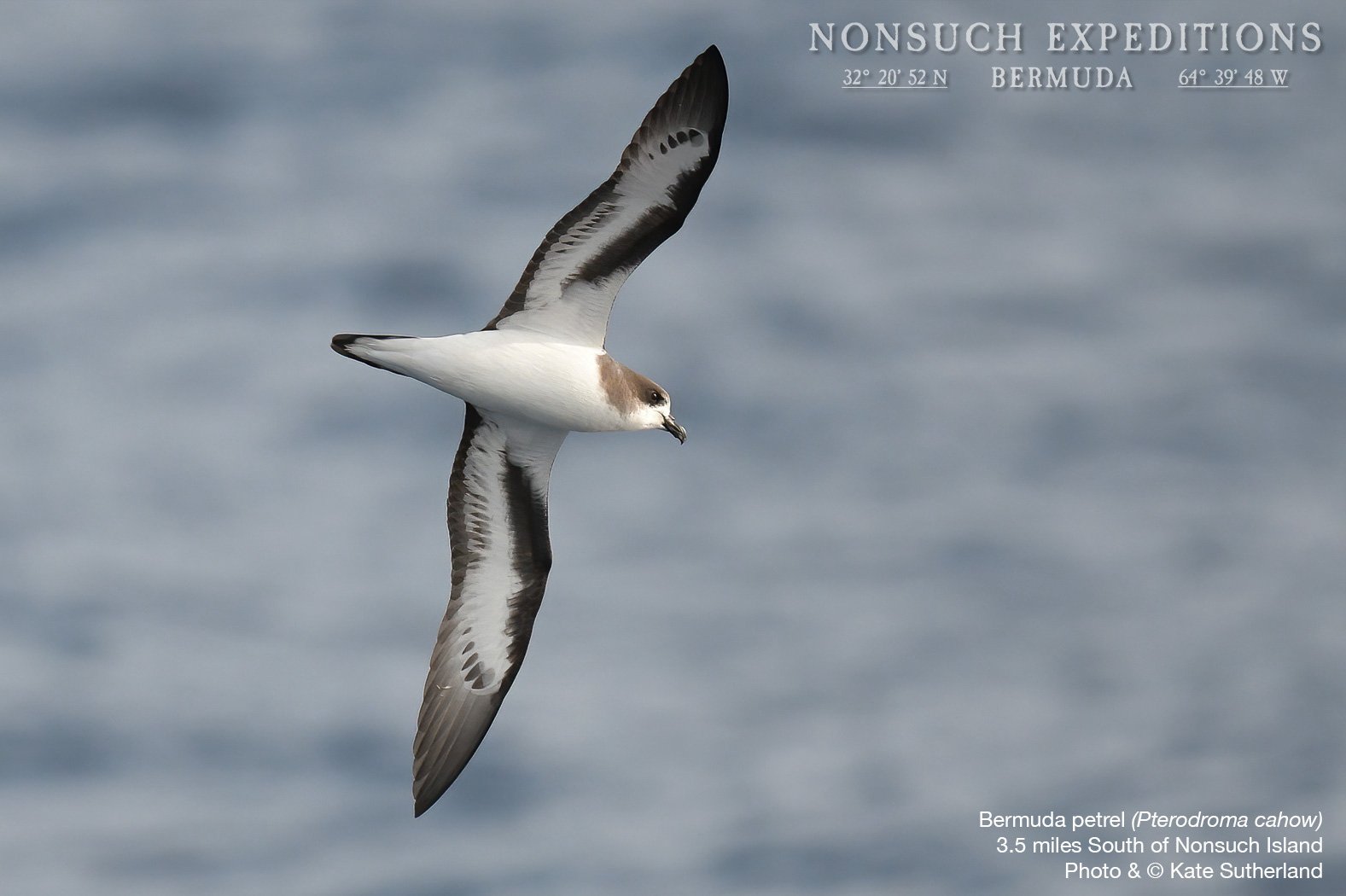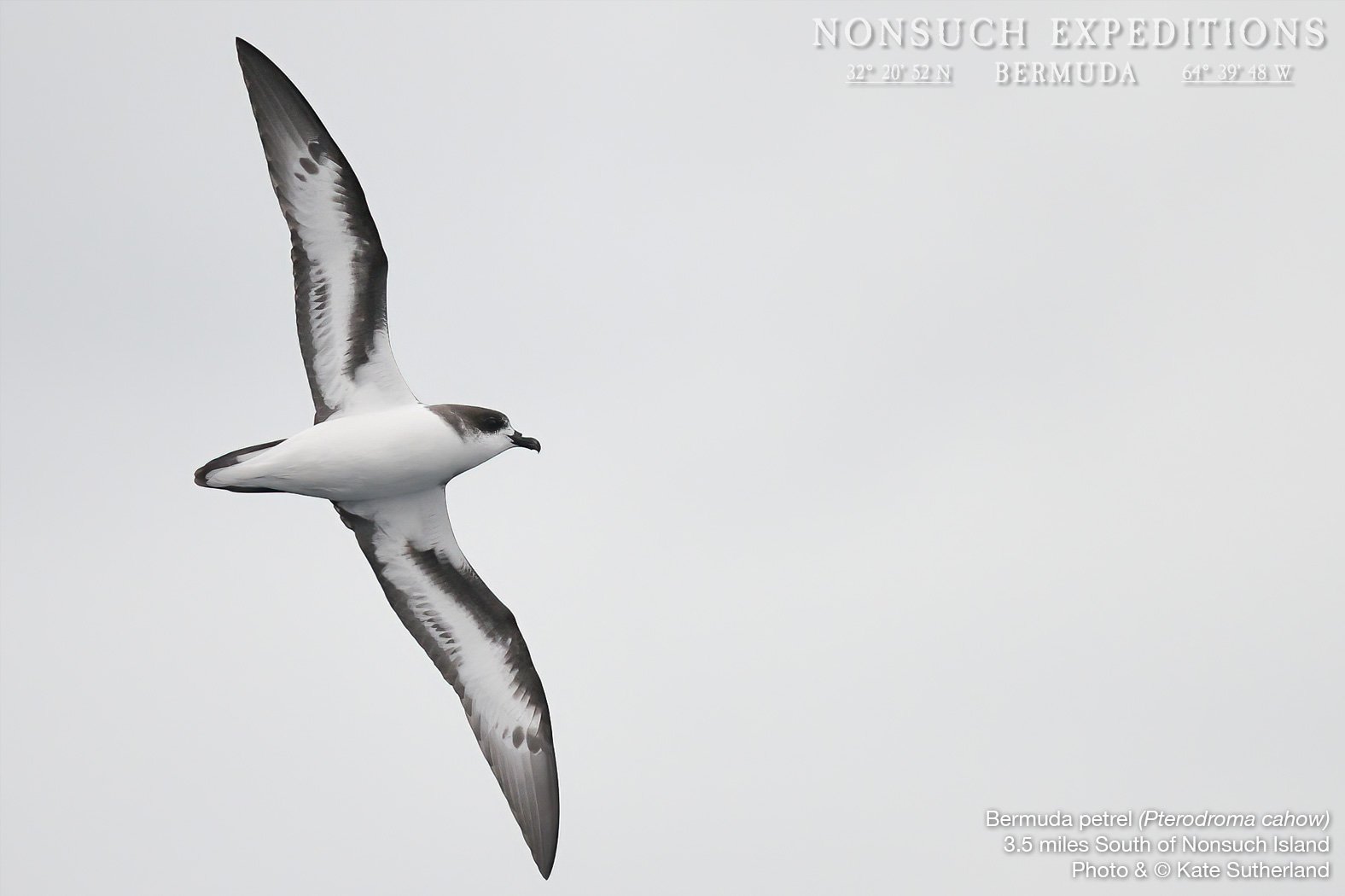Meet the 2023 Nonsuch Easter Chicks
Jeremy and the Easter Cahow chicks, Nonsuch Island Translocation Colonies A&B, April 8th 2023. Photography by Nonsuch Expeditions Founder and Team Leader Jean-Pierre Rouja.
Nonsuch Cahow colonies break records, however, hurricanes affect success on smaller islands.
“With the recent confirmation that there is a chick being fed in the first known natural Cahow burrow (dug out completely by the birds themselves) on Nonsuch Island in over 300 years, the two Nonsuch colonies now host a record number of 19 chicks! While this is proof that the nearly 20-year Cahow Translocation Projects (Two separate projects to establish the two different nesting colonies) have been successful, recent visits to the four smaller original nesting islets indicate that hatch rates on three are significantly lower than last year.
3 week old CahowCam 2 chick
This is partly due to erosion and flooding of these lower-lying islets during hurricanes "Earl" and "Fiona" in September 2022, which submerged many of the nest burrows under salt water from huge waves, more than 25' high. A number of nest burrows were damaged or their heavy concrete nest lids washed away, making extensive repairs necessary, especially on the worst affected islets of Green Island and Long Rock.
When nest burrows are submerged, this often reduces the following season's hatch rates, due to the rocks making up the burrows being saturated with salt. The salt is hygroscopic, absorbing moisture from the humid air and making the burrows permanently wet. It can take a couple of years for all the salt to seep out of the rocks so the burrows can dry out, improving hatch rates again.
On Nonsuch, there are now a total of 37 active breeding pairs (29 pairs at the "A" colony and 8 pairs at the "B" colony), of which 19 have been successful and produced chicks this season. In addition, there were 4 completely new prospecting pairs of young Cahows taking possession of empty artificial nest burrows, 2 each at both nesting colonies. Preparation has already begun for the construction/installation of additional artificial nest burrows to accommodate the growing Cahow population on Nonsuch Island.
Following recent surveys of all of the nesting islands, there appear to be 71-72 chicks in total for this nesting season. This is down from 2022s record number of 78 successfully fledged Cahow chicks, due largely to the after-effects of last year's two hurricane impacts.
Although this number is a bit disappointing, overall the total number of confirmed active breeding pairs of Cahows has risen to a record number of 164, indicating that overall, the Cahow breeding population continues its slow recovery from the edge of extinction."
Jeremy Madeiros | Chief Terrestrial Conservation Officer.
18 confirmed Nonsuch chicks are a testament to the success of the Cahow Translocation Project
As a testament to the success of the groundbreaking Translocation project being conducted by Jeremy Madeiros and his team over the past 20 years, there are 18 confirmed chicks this year, between Nonsuch Translocation Colonies A & B. In parallel the CahowCams now in their 10th year continue to offer a view into the otherwise secretive lives of the Cahows hidden in their underground burrows. (see below)
For context, Cahows were exterminated by introduced mammal predators and hunting by the early English colonists by 1620 from Nonsuch Island and were also thought to be completely extinct throughout Bermuda (and globally) by that time.
They were not rediscovered until 1951, when only 18 breeding pairs were found nesting on 4 tiny isolated half-acre rocky islets. These were so difficult to access that they were rarely visited by humans and were so small and rocky that even predators such as rats could not survive for long. It required the development of new techniques and technology by researchers in New Zealand, Australia and the United States to enable Jeremy and his team to carry out translocation projects to re-introduce the Cahow to Nonsuch Island, which is much larger and more elevated than the original nesting islets.
The first Cahows were translocated to Nonsuch “Colony A” as chicks between 2004 and 2008, with the first of these fledged chicks returning to the island by 2008 to choose nesting burrows and attract mates. The first breeding pair nested the following year, producing the first known Cahow chick since 1620 to hatch and fledge on Nonsuch in 2009. A second translocation project moved chicks to a second site on Nonsuch between 2013 and 2017 to “Colony B”.
Since that first breeding pair and chick, in the last 14 years, the number of breeding pairs at both sites has increased to a total of 34 in 2023, with the number of confirmed chicks at a record number of 18, with a possible 19th chick in a deep natural burrow.
In addition, a total of 25 Cahow chicks were also confirmed on the 23rd March at one of the original nesting islets. Three other small nesting islets still have to be visited to confirm just how many chicks have hatched there, as conditions have generally been so rough and/or windy that safe landings have so far been impossible there.
In addition to the record number of hatched chicks at the two translocation colony sites, Nonsuch Island is also experiencing a increase in the number of returning, or prospecting nonsuch-hatched Cahows, which have spent 3 to 5 years at sea since fledging as chicks from nests on the island.
As the parent birds were translocated or moved as chicks from their original nests on the original tiny nesting islets, these "first-generation" Nonsuch-born birds are now driving the accelerating increase in the breeding colonies there and are also attracting many young Cahows originating on the original islets to pair up and nest on Nonsuch.
This may be due to the fact that the original islets have been heavily eroded and flooded by hurricane and storm events at their exposed locations near the edge of the reef line, increasingly compounded by accelerating sea-level rise, to the point where two islets may no longer be useable by Cahows in the nest 20 to 30 years. Another islet has partially collapsed due to severe hurricane erosion, and it seems like the surviving birds from these islets instinctively sense that Nonsuch is a larger, more elevated and safer place to nest and raise their single chicks.
CahowCam Observations
Prospecting Cahow interacting with 3 day-old chick.
The CahowCams now in their 10th year continue to offer a view into the otherwise secretive lives of the Cahows hidden in their underground burrows. This year for example viewers have been able to witness the ongoing interactions between the CahowCam1 pair as they continue to bond several weeks after the egg was due to hatch and now 10 days since it clearly failed and was removed from the nest.
Over in CahowCam2 we have been able to observe a younger prospecting cahow that has been visiting the nest almost nightly since the chick was only three days old. As the colony becomes more and more successful and increasing number of birds start returning before Jeremy and the team can build additional burrows for them to move into, there are going to be more and more of these interactions. It's passive-aggressive reactions with the chick hint at how easily these interactions could escalate and go wrong. These prospecting birds however will return to the open ocean by the beginning of April, leaving the chicks in peace and only being visited by the adult birds bringing food back from the open ocean on their multi-thousand-mile foraging trips.
The CahowCam2 chick is doing well
The CahowCam2 chick seen in screen captures from the Nonsuch Colony A SurfaceCam.
“I was finally able to get out briefly to Nonsuch Island on Monday, 13th March, to check out how many Cahow chicks had hatched at the two nesting colonies on the island and see if we had in fact exceeded last year's record of 15 fledged chicks. I can now report that I confirmed 18 hatched chicks on Nonsuch, with an additional "wild card" possible chick in a natural deep soil burrow dug under the roots of native Buttonwood trees at the "B" colony. (I cannot see the nest chamber to confirm a chick, and will have to see if adult visits continue until April to do so).
Most chicks have had recent feeding visits from adults, and the oldest have already increased from their hatch weight of 30-40 grams to almost 200 grams, indicating that the stormy North Atlantic Ocean is providing adequate food for the adult Cahows to gather on their multi-thousand-mile foraging trips to provision their chicks. Now, I just need a few more calmer periods to get out to the other nesting islands!”
Jeremy Madeiros, Chief Terrestrial Conservation Officer
Meanwhilst the failed egg in the CahowCam1, which if it had been fertile would have hatched in late February, ruptured whilst still being incubated by one of the parents. It then stuck to its plumage and was dragged out of the burrow with the parent retuning an hour later to rest before fully abandoning the nest the next day. This pair have on average produced a chick every other year which is on par for the species, and will now head back out to sea a few months early, which should give them more time to recharge and build up their fat reserves in time for next season.
The 2023 CahowCam 2 chick has hatched!
We have our CahowCam2 2023 Chick!
In the early hours of March 10th 2023, in the midst of a cold snap with sporadic hail throughout the night, the male Bermuda Petrel in Burrow #832, in Translocation Colony A, on Nonsuch Island in Bermuda, (from which the CahowCam2 camera is LIVEstreaming), welcomed his latest chick to the World!
As J-P, Jeremy and followers from around the World watched in real-time @1:46 am the partially hatched chick was finally revealed, less than 2 days since the first “pip” was seen @8:58 on March 8th.
Then @3:08am the fully hatched chick was seen, now covered in leaves, and finally, @5:38am we were able to see the now almost completely dry, downy chick!
After resting from the hatching process, the young chick begins interacting with the adult, peeping and poking around the adult's face, signaling hunger and setting up for its first feeding from its father. @8:48 it had its first meal.
Continue watching the LIVEstream here.
Jeremy Madeiros: “A continuing long period of strong, sometimes gale-force winds with only brief periods of calm have really prevented all but a very few survey trips out to Nonsuch and the other Cahow nesting islands all through February, and now into March, a period when the single Cahow chicks begin to hatch after their 50 - 53 day incubation period. This is unfortunate for me as a conservation manager trying to determine the hatching dates, weight increase and health of the single chicks of these critically endangered seabirds. I was also keen to see if we would break last year's record of 15 fledged Cahow chicks produced by the Nonsuch nesting colonies.
During this nesting season (beginning in late October 2022 and extending to June 2023) a total of 33 active Cahow nests had been confirmed at the two nesting colonies on Nonsuch. Although candling showed that some of the eggs had failed or were infertile, by late January there were a total of 24 fertile eggs being incubated by the adult birds ,
During a check on the 23rd February, I found that 3 Cahow chicks had already hatched, while in 5 additional nest burrows, eggs were in various stages of hatching, a process that can take 2 to 5 days for the Cahow.
On my last check on Thursday 2nd March, i was able to confirm that the number of hatched Cahow chicks on Nonsuch Island had risen to 8, while an additional 6 nests had eggs in various stages of hatching. One chick had died shortly after hatching, of unknown causes, while another 5 nests had fertile eggs still being incubated. Although strong winds have kept me ashore since then, we were able to observe the hatching of the R832 (CahowCam2) chick over the night of 9th/10th March. In addition, I would expect that the 6 eggs seen hatching on the 2nd March will have all produced hatched chicks by now, bringing the total number of Cahow chicks on Nonsuch to at least 15. And we still have 5 late eggs that have a good chance to produce chicks, meaning that the total number of Cahow chicks on Nonsuch for 2023 may end up being 18 to 20.
Although strong winds are not so good news for getting out to Nonsuch, it is great for Cahows, being the consummate creatures of the wind that they are. My check a week ago confirmed that all of the chicks were being fed and were at higher than, average weights for their ages, indicating that the birds were using the strong winds to make fast feeding visits to gather food for their chicks. As a result, I can't wait to get back out to the islands. We will report our findings at that time.”
Jeremy Madeiros, Principle Conservation Officer (Terrestrial Conservation), Dept. of Environment and Natural Resources, BERMUDA
A Big Thanks to Horizon Communications for this Season’s wireless internet connection!
Hatching Alert for the CahowCam2 LiveStream of one of the rarest seabirds in the World!
UPDATE March 10th, 2023 @ 12:10 am: We have been hearing sporadic peeps for the past few hours, but the male has been hiding the egg and/or chick, so we are not sure if it is calling out from inside the egg, or if it has fully hatched yet…
March 9th 2023 - Nonsuch Island, Bermuda > Translocation Colony A > Burrow #832 (Skip direct to LIVEstream)
At 8:58 Bermuda time on March 8th, one of the many LIVEstream followers alerted the NonsuchExpeditions Team to a visible “pip” or small hole on the egg in the CahowCam2 burrow when it was briefly revealed by the female.
“Pipping” is the process through which the chick chips away at the the inside of the egg, at first creating “dimples” or outward facing dents or ripples in the shell and then eventually a small hole which is the start of the hatching process. This process can take as little as a few hours or up to several days before, if all goes well it fully emerges.
Watch this process in real-time via our LIVEstream here and sign-up for our newsletter for “CahowCam Alerts” here, for more frequent updates.
*As of Jeremy’s last visit to Nonsuch on March 2nd, on Nonsuch there were already 8 chicks and 6 more that were pipping.
A Big Thanks to Horizon Communications for this Season’s wireless internet connection!
Sargasso Sea Images show what was at Stake in High Seas Treaty Negotiations
UPDATE : March 5th 2023 The BBNJ agreement has been finalized!!! - This is the first international agreement on the ocean since the UN Convention on the Law of the Sea was signed in 1982. It is the first internationally legally binding instrument for the high seas. "The ship has reached the shore," BBNJ President Rena Lee said after a marathon 38 hours of talks concluded on Saturday. A resumed meeting will be convened to adopt the final text at a date to be announced.
ORIGINAL ARTICLE: The high seas, vast open ocean ecosystems located miles from land, are inaccessible to most people due to their remoteness. However, they are fundamental in supporting all life on Earth – producing the oxygen for every second breath we take, acting as reservoirs for biodiversity including great whales and pelagic fish, as well as mitigating the effects of climate change by absorbing excess heat and sequestering carbon.
The only way that many people will ever get to visit these fascinating ecosystems is through images. Nonsuch Expeditions founder and Sargasso Sea ambassador JP Rouja collaborates with the Sargasso Sea Commission to bring awareness to the often-overlooked world of the high seas.
The Sargasso Sea is a two-million square mile open ocean ecosystem, bounded by the circulating currents of the North Atlantic Gyre. The foundation of this incredible pelagic ecosystem is the floating, golden Sargassum seaweed for which the sea is named. As well as supporting ten fascinating endemic species, Sargassum acts as critical nursery habitat for many species of pelagic fish and several species of sea turtle. The Sargasso Sea is the only known spawning area for two species of endangered anguillid eel – which transition from marine breeding grounds to freshwater feeding grounds. It also acts as a migratory corridor for several species of sharks, rays, and cetaceans. The Sargasso Sea is threatened by various pressures – including impacts from shipping, fishing, plastic and other pollutants, and climate change.
Bermuda is the only land mass in the Sargasso Sea, and we are lucky enough to be able to observe evidence of this incredible ecosystem on our own shores – by looking through Sargassum that washes up.
In the above pictures, you can see typical examples of Sargassum rafting communities, bursting with life. Various fish and invertebrates make their home within the floating algae on the high seas, including the Sargassum swimming crab, a fearsome hunter that can use its paddle-like legs to swim back to Sargassum if it becomes separated from it. Also pictured is perhaps the most iconic Sargassum endemic, the Sargassum frogfish, an ambush predator capable of crawling around on the algae with its prehensile fins. The background is taken up by a mass of flying fish eggs – these strange fish make nests in Sargassum and attach their eggs to the algae with sticky filaments.
However, this thriving community, like so many high seas ecosystems, is under threat.
Located in areas beyond national jurisdiction (ABNJ), the high seas are not owned by any one country – they belong to everyone, but lack of effective regulations has turned them in to a ‘tragedy of the commons’ – where anyone can fish them, transit through them, and extract resources, and differing capacities to access the high seas means that only select countries benefit from what is meant to be ‘the common heritage of mankind.’
The UN Convention on the Law of the Sea (UNCLOS) provides a framework for the governance of areas beyond national jurisdiction (ABNJ) based on two legal regimes:
the seabed located beyond the continental shelf, the resources of which are governed by the International Seabed Authority as part of the ‘Common Heritage of Mankind’
the water column above the seabed, that is governed by the principle of ‘Freedom of the High seas’ – giving all states liberty to navigate through and fish high seas waters, among other freedoms.
The existing legal framework has been described as an “unfinished agenda” – at the moment, the governance of the high seas is achieved through a patchwork of regional and sectoral organisations, which leaves many governance gaps.
How can this system be improved? An internationally legally binding treaty.
The BBNJ agreement
UPDATE : March 5th 2023 the BBNJ talks have succeeded!
At the end of today (March 3, 2023), negotiations on the first internationally binding treaty for the high seas will conclude in New York. Discussions on an instrument under the United Nations Convention on the Law of the Sea (UNCLOS) on the conservation and sustainable use of marine biological diversity of areas beyond national jurisdiction (BBNJ) have been going on for over a decade. After the treaty failed to reach the finish line at a previous session in August 2022, it is hoped that delegates will be able to conclude a strong high seas treaty now, in what has been described as a “once in a lifetime” chance to finally protect the high seas.
The BBNJ agreement will for the first time provide a more holistic governance system for ocean areas beyond national jurisdiction – it will create a Conference of the Parties for the high seas, among other reforms.
There are five main areas of negotiation within the agreement:
Area-based management tools (ABMTs) including Marine Protected Areas (MPAs)
Environmental impact assessment (EIAs)
Marine genetic resources (MGRs)
Capacity-building and the transfer of marine technology (CB&TMT)
· Cross-cutting issues (CCI)
For in depth discussions of the issues being debated, check out coverage by Earth News Bulletin and the SARGADOM project.
How can the Sargasso Sea be protected?
For over a decade, the Sargasso Sea initiative - led by the government of Bermuda - has acted as the Steward of the Sargasso Sea and worked to keep its health, productivity, and resilience under review, as well as to develop safeguard measures for its conservation.
The Sargasso Sea Commission was established in 2014 by the signing of the Hamilton Declaration on Collaboration for the Conservation of the Sargasso Sea. It is a unique institution as Commissioners are appointed primarily according to their scientific and technical expertise, and serve in their personal capacity rather than being representatives of the Signatory Governments.
The Commission is appointed by the Government of Bermuda with the support of the ten Government Signatories of the Hamilton Declaration – the Azores, the Bahamas, Bermuda, British Virgin Islands, Canada, Cayman Islands, the Dominican Republic, the Principality of Monaco, the United Kingdom and the United States.
The Commission is the recipient of two separate but complementary grants, one from the French Facility for Global Environment and one from the the Global Environment Facility, which will enable the Commission to improve knowledge of the Sargasso Sea ecosystem and work with stakeholders to create a plan for the conservation and stewardship of the area, which will be fundamentally shaped by the outcome of the BBNJ agreement.
As the Honourable Minister Walter Roban, Deputy Premier of the Bermuda Government said at the 2022 UN Ocean Conference, “though we often feel as if they belong to no one, the high seas are the responsibility of everyone.” Finalising the BBNJ agreement will open up new ways to conserve the Sargasso Sea. Let’s hope that delegates today keep at the forefront of their minds the ecosystem services high seas areas provide, yes - but also the inherent ecological value, the magic, the beauty, of these spaces.
Written by Fae Sapsford - Marine Research Fellow for the Sargasso Sea Commission
The first of the 2023 Cahow chicks have hatched!
When Jeremy and JP conducted the latest Cahow check on Feb 23rd, they discovered that at least 3 chicks had already hatched in Nonsuch Translocation Colony A, with many more having started “pipping” their eggs from the inside which is the start of the 1 to 5 day hatching process.
Jeremy Madeiros: Last year only 2 chicks had hatched on Nonsuch by the end of February, and this year when everything seems to be starting sooner, we are on track for 6 to 8!
If all goes well, we also seem to be on track for a total of 18 to 20 chicks on Nonsuch this year, easily breaking last years record of 15, with similar success being seen in the other Cahow nesting islands in the wider Colony as well.
The Feb 23rd video starts with a health check of the CahowCam 2 burrow, where the very successful pair were amongst the latest to lay their egg this year on January 18th. This would put the expected hatching date to be around the 10th to the 14th of March, so be sure to continue to watch the LiveStream around that time. Unfortunately this year the egg in the CahowCam 1 burrow is infertile, however the parents will likely continue to try and incubate it for the next few weeks and their interaction are worth watching as well.
Skip to 17 minutes in the video to meet the first of the 3 newly hatched chicks that were found by Jeremy during the visit, whilst a video of the 3rd chick can be seen on Instagram.
Good News and Bad News for the CahowCam eggs
8 day old CahowCam2 egg “candling” indicating fertility
Bermuda Petrel/Cahow 2023 Breeding Season Update: January 26th 2023
Several survey trips to Nonsuch Island and the other Cahow nesting islands were carried out in the brief calmer gaps in the otherwise windy, rainy conditions that have been prevalent since November, 2022. In addition, the arrival of our two overseas collaborative researchers in January means that the next stage of study of the Cahow's At-sea Range has begun with the retrieval of GLS tags fitted 2 years ago to the legs of adult Cahows, and the deployment of additional tags of 3 different types, to check overall distances traveled, foraging areas and depth of feeding dives/amount of time spent on the surface of the ocean compared with flying time, etc. In addition, Carla Marquardt has begun the inspection & candling of Cahow eggs of differing ages to determine whether eggs are fertile or infertile, and to monitor embryo age, development and health.
On Nonsuch Island, essentially all breeding pairs have returned and have laid their eggs and begun incubation. Three additional new breeding pairs have laid their first eggs, bringing the total number of confirmed breeding pairs on Nonsuch to 33. In addition, 2 other established pairs returned but did not produce any eggs, and 3 new prospecting pairs established nest sites, bonded and will hopefully produce their first eggs next year.
We had a rare opportunity to check all four adult Cahows from the two CahowCam nests, as both pairs remained together in their nest burrows incubating their eggs. We were able to confirm that all four adults were in good condition and at good body weights. Carla was able to inspect both eggs, and there is both good and bad news; firstly, it was confirmed that the large egg in the CahowCam 1(R831) nest is definitely infertile. This possibly was the result of the female bird staying at the nest with the male for less than two weeks during the vital courtship, nest-building and mating stage of the breeding season in late October and November, (as confirmed by the CahowCam and flagged by several of our volunteers / followers), leaving extremely early on the 6th November. Normally Cahows fly to sea during the last days of November, and the male bird did in fact stay at and tend the nest faithfully for the rest of the month. The female may simply not have stayed together with the male long enough to ensure fertilization of the egg.
Note from JP: Whilst this egg failure is disappointing, it is within the historical success rate of this particular pair (+/- 50%) and in fact for the Colony as a whole, which averages around 55%, please see prior post explaining this.
Now, the good news is that Carla was able to confirm that the egg in the CahowCam 2 (R832) nest is indeed fertile, continuing the remarkably good breeding success history of this particular pair, which started nesting in 2010 and have produced a total of 11 successfully fledged chicks with only 2 failures in the 13 years up to 2022. This is one of the most successful breeding pairs on Nonsuch, and hopefully they will be able to add to this great record for this year!
We will continue to provide updates as the season progresses through the rest of the 50-53 day incubation period, with the first chicks due to hatch in early March.
Jeremy
Jeremy Madeiros Principle Conservation Officer (Terrestrial Conservation) Dept. of Environment and Natural Resources BERMUDA
CahowCam2 Female returns and lays egg, watch highlights from both nests.
On January 18th 2023 @7:17 pm, the female returned to the CahowCam2 burrow where her mate had been waiting patiently for the past 3 days.
They were last together in November for their courtship and nest-building rituals. They then spent the past 6 weeks on their own, feeding on the high-seas, so that she could develop her single egg (which can be up to 1/5th of her body weight!) and so that he could build up his fat reserves to sustain him through the first several weeks long incubation shift.
Whilst CahowCam viewers around the World watched, after some quick nestorations in the burrow, she quickly settled into the egg-laying process.
The top-down view of CahowCam2 (as opposed to the side view of CahowCam1) gave a perfect view of her tail feathers fanning out with each push until, only 48 minutes since her arrival, she had laid her egg.
Nonsuch Expeditions Founder and CahowCam developer J-P Rouja: “I was online when she first returned, and immediately set about notifying our followers from around the World, via our social media channels, and a special Newsletter list that we maintain for those that opt in for “CahowCam alerts”, (which gives them the opportunity to witness rare events such as this via our LiveStream). This time it happened so fast that I had barely finished posting everything, and she was done, so fortunately our video players allow viewers to rewind the prior 12 hours to catch up."
The laying process was even faster than that of their neighbors in the CahowCam1 burrow next door, where 10 days earlier, it had taken an hour, which years of CahowCam observations has shown to be quite common.
In the CahowCam2 burrow (see video below) the male waited just out of view guarding the tunnel, but minutes after the egg arrived he started coaxing her to handoff incubation duties, which several days later, she has yet to do completely.
Depending on the body condition of the females, they will often-times head back out to sea as soon as their mate is there to take over, leaving him to take on the first incubation shift that can last several weeks…
This year however, with female body weights and eggs heavier normal, they seem to have more energy reserves and are staying around for the first few days.
The egg laying sequence in the CahowCam1 burrow was equally interesting. In that case, the female arrived at 3:15 am and had laid her egg by 4:15am, in the interim though, the sideview camera documented a whole range of activities including, possibly for the first time ever, the egg as it first appears. In their case the male stayed by her side throughout the process allopreening and comforting her as she went through her contractions.
Watch the replay here:
The Nonsuch Expeditions CahowCams, now in their 10th year, keep adding to the knowledge base of the secret lives of these rarest of birds, and in doing so contribute to their recovery.
Jeremy Madeiros: "Allopreening, as has now been documented by the Cams, is usually carried out between both members of an established pair to calm and reassure each other, and to cancel and neutralize any aggression between the individuals, often seen when pairs first see each other after spending weeks or months mostly alone on the open ocean. The adults will similarly preen the chicks for 5 to 10 minutes before feeding them, as the chick is so aggressive and desperate for food that the parents cannot feed it, and the preening noticeably calms the chick enough to permit the proper transfer of food."
Last season there was a record 156 confirmed pairs that produced an egg from which a record number of 77 chicks fledged successfully, records which we hope to break again this season.
"Cahows have a relatively low breeding success rate of 49% to 56%, although 60% has been attained a couple of years through considerable management of almost every breeding pair. In contrast, the White-tailed Tropicbird, or Longtail, which also nests on Nonsuch and the other nesting islands typically have breeding success rates of 68% to 80%. This may be partly due to the longer egg incubation period, and also to the fact that Cahows are much longer-lived than Tropicbirds, at 40-50 years compared to 18-25 years, which leads to a higher buildup of pesticide and chemical residues in their tissues from agricultural and industrial runoff into the world's oceans. Another source of for example heavy metals such as lead and mercury are from coal-fired power stations, with the exhaust plumes containing microscopic particles of these materials, which can blow from the continents thousand of miles to sea, where they settle out in rain."
This relatively high failure rate is something that the team continues to study, with more research being conducted this year in collaboration with visiting scientists. Stay tuned for updates throughout the season.
"At this point on the 23rd January, all breeding pairs have now essentially returned and are incubating their eggs in their nest burrows. The first chicks should start to hatch during the last few days of February, following the 50 to 53-day incubation period."
To watch the LiveStreams and highlight replays of key events, visit our dedicated CahowCam page.
Imminent return of CahowCam2 pair expected, as egg laying continues throughout the Colony
2023 CahowCam1 egg is revealed
All eyes are on the CahowCam LiveSteams as followers from around the World await the return of the CahowCam2 pair to their burrow, which despite an apparent false-alarm due to a visiting prospector the night before, is still empty as of 8pm on Jan 14th.
Update#1: The male returned in the early hours of the 15th and remains in the burrow waiting for his mate.
Update#2: The female returned @7:17pm on the 18th, and by 8:05pm she had laid her egg!!!
The resident pair are traditionally amongst the latest to return and lay their egg, and are expected back in the next few nights. Watch the LiveStream here over the next few evenings (or sign up for our Newsletter’s CahowCam Alerts option) and as with the recently returned CahowCam1 pair, their egg is usually laid within hours of the female’s return.
Here is the latest Nesting Season / Colony update from Jeremy:
“Despite frequent winter weather systems passing through the Bermuda area over the last 2 weeks, there were actually some calmer periods where J-P and I have been able to get onto some of the Cahow Nesting Islands and begin monitoring the return of the first of the Cahows from their 5-week pre-egg laying exodus out on the open ocean.
On 30th December, 2022, during a check to bring grass clippings to make nests in the nest burrows for the birds on the rugged, rocky Green Island, which lacks its own vegetation for the birds to make nests with, I was only able to confirm one nest with a returned Cahow.
By the 3rd January 2023, a visit to Horn Rock revealed that Cahows had returned to 6 nests, in which 3 already had birds incubating eggs.
By the 4th January, Nonsuch had the first returning birds, with Cahows returned to 5 nest burrows, with eggs being incubated in 4 of them. On the same day, a visit to Long Rock revealed 5 nest burrows there with returned birds, including a pair together. 4 of these contained eggs that were being incubated by the adult birds.
Finally, on Monday 9th January, a check at the Nonsuch Island "A" nesting colony showed the continuing return of Cahows by revealing that the number of Cahow nest burrows with returned Cahows in them had increased to 15, with eggs being incubated in 12 of them.
These included the newly arrived "CahowCam 1" nesting pair, which had just returned. The male bird (band # E0197) had returned on the 6th/7th January and weighed in at an impressive 420 grams. The female bird (band # E0212) was also at an impressive weight of 362 grams, which is the heaviest weight i have ever weighed a female Cahow at only one day after laying an egg that weighed 60 grams. This means that before this female laid her egg, she also would have weighed over 420 grams. This particular bird is one of the largest female Cahows in the entire breeding population, and after spending one more day in the nest incubating the egg with the male, she departed out to sea to feed and regain her energy after producing her single large egg, which can weigh more than 20% of the body mass of the female. The egg will now be incubated for the next 50-53 days by both adult birds, and after a generally longer first shift by the male they will alternate in 5-7 day "shifts".
We will commence further visits for candling the eggs, for which Carla Marquardt will be accompanying us for the 5th year. The 2023 Cahow breeding season is moving into high gear, and the remaining Cahows in the population should all return within the next 2 weeks.”
Jeremy
Witness the laying of the 2023 CahowCam1 egg!
Watch the much anticipated return of the female Cahow from burrow #831, in translocation Colony A, on Nonsuch Island in Bermuda, right on schedule @3:15am on January the 8th 2023. It was welcomed by its anxious mate which had arrived a day and half earlier and just as predicted by Jermey, backed up be a decade of CahowCam observations, she laid her single egg exactly an hour later @4:15am.
Watch what is currently going on in the nest in real-time via the CahowCam LiveStream here and watch the replay the 2 hour video archive sequence from January 8th including the female returning at 3:15 am on the 8th and laying her egg at 4:15 am in the video below:
The Male Cahow has returned to the CahowCam1 burrow.
UPDATE January 8th: The female has now also returned and laid her egg! See new post.
Original January 6th Post: “One of the Cahows nesting in the CahowCam 1 nest burrow on Nonsuch Island returned from their pre-egg laying exodus tonight (Friday 6th January 2023) at 6.33pm, Watch the CahowCam LIVEstreams here. in the strengthening winds ahead of a cold front approaching Bermuda. This is right about on time for this pair, as generally one or the other of this nesting pair usually returns on the 5th to 6th of January every year - sometimes the male arrives first, other years it is the female. This year, I am pretty sure that it is the male that has returned first. At this point, there is nothing for him to do except re-arrange the nest material and wait for the female to return to lay her single egg. The female, after carrying out courtship, mating and nest-building with the male bird in late October and early November, left for the open sea unusually early this season. (All Cahows return to sea for 4 to 5 weeks in December to intensively feed, the female to develop her egg, and the male to build up fat reserves so he can carry out the first long incubation shift after the female returns to lay). The first-returning bird of this pair sometimes has to wait up to 5 or 6 days before their mate returns, so he, and we, will just have to wait impatiently!
Several other Cahows were also seen flying around the surface cam earlier in the evening, so it looks like a number of birds were taking advantage of the strengthening winds and overcast skies to return tonight. When I carried out the last check at the "A" Cahow colony at Nonsuch Island on Wednesday, Cahows had already returned to 5 nests on this colony, with birds already incubating eggs in 4 of them. This number has probably doubled in the last couple of days, but i will likely have to wait for at least a couple of days before my next check, as strong winds are forecast after the cold front passes (it is thundering outside as I write this update), and I will have to wait for conditions to calm a bit before JP & I can travel out to the island in my 17' work boat. Hopefully by then the female will have returned and we will keep our fingers crossed!"
Watch the CahowCam LIVEstreams here.
Jeremy Madeiros, Principle Scientist (Terrestrial Conservation), Dept. of Environment and Natural Resources, BERMUDA
Progress Report on the 2022 - 2023 Cahow Breeding SeasoN
This current (2022 / 2023) breeding season was affected by the 2022 Hurricane Season, with 2 hurricanes closely missing Bermuda. Hurricane "Earl" passed only 82 miles southeast of the island on September 8th to 9th as a Category 2 storm. Whilst the winds on Bermuda gusted only to 67 mph, large ocean swells produced by the storm still caused some erosion on the South Shore and the Cahow nesting islands.
Hurricane Repair Team: Nonsuch Expeditions J-P Rouja with DENR’s Peter Drew and Jeremy Madeiros.
The much more powerful Hurricane "Fiona" passed only 112 miles west of Bermuda on the 23rd of September as a Category 4 storm with sustained 140 mph winds. Despite the distance, winds on Bermuda gusted to 113 mph, knocking out power over most of Bermuda and causing damage to structures and trees. In addition, The South Shore of Bermuda was impacted by huge storm waves of 25' to 35', Causing considerable erosion and flooding. Some of the Cahow nesting islands were badly affected by the huge waves during hurricane "Fiona", with a number of the concrete nest burrows damaged or filled with rocks and debris, particularly on Green Island and Long Rock. However, thanks to help from Peter Drew and JP Rouja, all nests were repaired with concrete barely in time for the return of the first Cahows, despite prolonged windy, rough conditions hindering the work during much of October.
The first Cahows were recorded back in their nest burrows quite early on the 16th to 18th October, with the entire breeding population back by the beginning of November. Windy, rainy weather continued through most of the November courtship period, although the windy weather favored the courtship activity of these tough pelagic seabirds.
This resulted in good sightings of near-record numbers of Cahows during pelagic birding trips on the "Endurance" boat. These trips were carried out by both the Bermuda Audubon Society and Robert Flood's "Cahow Experience" (see slideshow above with photos by Kate Sutherland) which combines pelagic boat trips to see Cahows on the open ocean, a tour of Nonsuch Island and a visit to the Cahow nesting colonies there, and land birding trips to see the wide range of migrant and resident landbirds to be found on Bermuda during the autumn period.
After the cahows left and returned to the open sea for what is known as the "Pre-egg laying period" during the month of December, further improvements were made to over 20 Cahow nest burrows on Nonsuch Island and Horn Rock. The first returning adult Cahows were then recorded on Green Island by the 30th December, and we are now waiting for the imminent return of the rest of the population in early January 2023 to lay their single eggs and begin the 53-day incubation period.
Although it is still too early to know the exact number of confirmed breeding pairs until all birds have returned to lay their eggs (only pairs that produce an egg, whether it hatches or not, are counted as actively breeding pairs), it looks like 2022s record of 156 breeding pairs will be easily exceeded, with hopefully at least 8 new pairs likely to come "on-line" and produce their first eggs. One new development of note is that prospecting visits to the nesting colonies on Nonsuch by newly returned, young male Cahows continued through much of November and the exodus period in December. This is highly unusual, as most prospecting by young adults looking for nest sites does not occur until February and March. It will be interesting to see whether this is a one-time event or is new behavior related to the continuing increase in numbers of nesting Cahows.
Watch the CahowCam LIVE Streams here
Jeremy Madeiros | Chief Terrestrial Conservation Officer
A RECORD YEAR FOR BERMUDA’S NATIONAL BIRD - 2022 CAHOW RECOVERY PROGRAM UPDATE
The Bermuda Petrel (Cahow) Pterodroma cahow is a pelagic seabird not often seen by the public on Bermuda, despite being officially declared as the island’s National Bird in 2003. It is endemic to the Islands of Bermuda, nesting no-where else on Earth. In contrast to the well-known Longtail, or Tropicbird, which is highly visible during daylight hours around Bermuda’s coastlines during the Spring and Summer months, the Cahow only approaches land at night, nesting during the Winter and Spring on a few offshore islands in the Castle Harbour area.
Originally abundant, the Cahow numbered as many as half a million pairs at the time of Bermuda’s discovery in the early 1500s, but was catastrophically impacted by the introduction of pigs of mammal predators such as rats, cats, dogs and hogs. By the 1620s the Cahow was thought to be extinct, a belief that persisted for 330 years until the rediscovery in 1951 of a tiny remnant population on four small, rocky half-acre offshore islets.
The Bermuda Petrel (Cahow) Recovery Program is a long-term management, research and recovery program that has been in place since 1960, with a primary objective being the recovery of the Cahow’s breeding population through the following:
a) The control of threats to the species;
b) The construction of artificial concrete nesting burrows, to compensate for a lack of suitable natural burrows on the tiny soilless nesting islands;
c) The establishment of entirely new nesting colonies on larger islands less vulnerable to hurricane erosion and flooding and sea-level rise.
Other primary objectives of the program include the following:
1) to promote public education and understanding of the importance of the Cahow to the natural heritage and unique natural environment of Bermuda, as well as the cultural significance of the species.
2) to use new technology and techniques to determine the oceanic range and significant foraging areas for the species, and to determine if there are threats such as offshore oil and gas exploration and extraction, that may overlap with the Cahow’s oceanic range.
The Cahow Recovery Program has been successful in addressing most of the threats affecting the Cahow on the breeding islands in Bermuda, enabling the population to increase from only 18 breeding pairs producing a combined total of 7 to 8 chicks annually in the early 1960s, to a record number of 156 breeding pairs in 2022, producing a record total of 77 successfully fledged chicks. This is up from 143 pairs producing 71 fledged chicks in 2021.
One of the main concerns for the future survival and continued recovery of the Cahow is the effect of climate change and global warming on the tiny original offshore nesting islets on Bermuda. This is primarily due to the impacts of sea-level rise on the islands, most of which are of very low elevation, and of stronger, more frequent hurricane events, which have caused massive erosion and flooding from huge waves and storm surge on these exposed islands.
To address the threats caused by climate change, new Cahow nesting colonies have been established on the nearby larger, more elevated Nonsuch Island Nature Reserve. Nonsuch is seven times larger than the combined area of all four original nesting islands, and has been restored since 1964 as a “Living Museum” with the original endemic and native forest cover and animal communities that used to cover the main islands of Bermuda, but have been almost completely replaced by introduced invasive species.
Fig. 2: Location of newly established Cahow nesting colonies on Nonsuch Island
Two nesting colonies of Cahows were established in separate projects by the Terrestrial Conservation Officer in 2004-2008 and 2013-2017 through the translocation of near-fledged chicks from the original islands to artificial concrete nest burrows constructed on Nonsuch *(Fig. 2). Chicks are monitored through their development and moved to the new nests about 21 days before fledging. They are then hand-fed fresh Squid and Anchovies every day, until they fledge to sea, not returning for 3 to 5 years. The two translocation projects have been successful with a 49 % return rate of fledged chicks, leading to the first nesting pairs and hatched chicks by 2009 to be recorded on Nonsuch Island since the 1620s. These nesting colonies have rapidly grown by 2022 to become the second-largest sub-population of all the nesting islands at 35 breeding pairs, and continue to grow and attract even non-translocated Cahows from the original islands. This is largely due to the fact that the new colonies are located at a much higher elevation on Nonsuch than on any of the other islands, and have not been disrupted or damaged by hurricane waves, storm surge and erosion.
During the 2022 breeding season, work was carried out retrieving Geolocator (GLS) tags that were fitted to the legs of adult Cahows 1 to 2 years before, enabling tracking of their movements at sea and identifying important feeding areas, which include the grand banks east of Nova Scotia and cooler, more productive waters well north of the Gulf Stream. In May and June, 37 GLS tags were fitted for the first time to fledglings just about to leave the nests, which will gather data for 3 years, archiving it until the tags can be recovered when the young birds return to nest. This will fill an important gap in knowledge, as nothing is presently known about where young Cahows go during the years when they are exploring and learning to survive on the open ocean.
Work was also carried out upgrading the highly successful live-stream “CahowCam” infrared video system on the island, the result of our partnership with J.P. Rouja, founder and tech developer for the Nonsuch Expeditions, and the Cornell Bird Laboratory. These videos enable a local and international audience to observe the nesting activities and chick rearing of Cahows in their underground burrows.
Despite the continuing recovery of the Cahow, it is still critically endangered and one of the rarest seabirds on Earth. Continued management, to control both old and new, emerging threats, will be essential to enable the continued recovery of Bermuda’s beautiful National Bird.
Report compiled by: Jeremy L. Madeiros, Principle Terrestrial Conservation Officer, Terrestrial Conservation Division, Department of Environment and Natural Resources, BERMUDA
Meet the male from CahowCam2, as 2023 nesting season is well under way
November 20th > Jeremy conducts a health check on burrow #R832 where the CahowCam2 camera is embedded and finds the male, one of the largest in the Colony!
The pair were both separately translocated to Nonsuch Colony A in 2005 from outer nesting islands, and returned a few years later and paired up. They are now one of the most successful pairs in the Colony having produced a chick 11 out of the past 12 years…
Watch the video below, and their Live Stream here
Tour of Nonsuch Cahow Translocation Colony B
Jeremy recovers a Cahow with a GLS archival tracking tag that is nesting in Colony B
November 14th > Part way through the traditional Cahow nest building and courtship period at the start of the 2022/23 nesting season, Jeremy gives us a rare tour of Translocation Colony “B” on Nonsuch Island.
Along the way he shows us the first known natural cahow nest on Nonsuch in over 300 years, confirms several new prospecting pairs, conducts a health check on a very vocal pair, and recovers a Cahow with a GLS tag that has been tracking its activities for the past 18 months…
Watch the video here:
After a suspenseful week, the CahowCam2 pair have finally reunited
November 4th @ 9pm the CahowCam 2 pair have finally reunited!
The male had arrived on October 30th and for the past week has been waiting for his mate to return, whilst many of our online followers became increasingly concerned. As luck would have it he finally took a feeding break last night, just missing her when she arrived an hour later, but after spending the day at sea feeding he finally connected with her this evening.
As Jeremy noted however, this seems to be the norm for this pair who are far less synchronized than their neighbors a few feet away in the CahowCam1 burrow, who this year once again returned within hours of each other despite having spent the past few months thousands of miles apart.
They're Back!!! The CahowCam 1 pair have returned for the start of the 2022/23 nesting season.
October 25th: Our star CahowCam 1 pair have returned to their burrow on Nonsuch Island, for the official start of the the CahowCam nesting season. Watch their LIVEstream here
“These long-lived, mainly monogamous birds are so synchronized with each other, that even after being separated by thousands of miles for the last 5 months, they arrive back at the burrow within hours of each other. It never ceases to amaze me.
They spend the non-breeding period widely separated, as both birds were fitted with GLS tags in the past. The male (band no. E0197) bird summers northwest of the Azores Islands, 2400 miles northeast of Bermuda, while the female (band no. E0212) goes south of Nova Scotia, hundreds of miles to the North of Bermuda.”
Jeremy Madeiros Chief Terrestrial Conservation Officer
The will spend the next few weeks nest building and copulating, will head back out to sea for December to feed and recharge then the female will return to lay here single egg in early January. Her mate usually returns to take on the first incubation shift within hours which they alternate until, if all goes well, the check hatches around early March. They the spend the next 3 months on feeding runs ranging anywhere from a few hundred to several thousand miles per trip until the chick fledges in late May / early June.
This it the 10th year / 11th season that LookBermuda’s Nonsuch Expeditions custom built CahowCams have been filming and LIVEstreaming from the underground burrows on Nonsuch Island with 10’s of millions of minutes of video now having been watched by researchers, students and followers from around the World.


































